May 8 - 14 2016: Issue 262
The Basin, Pittwater: A Reprise
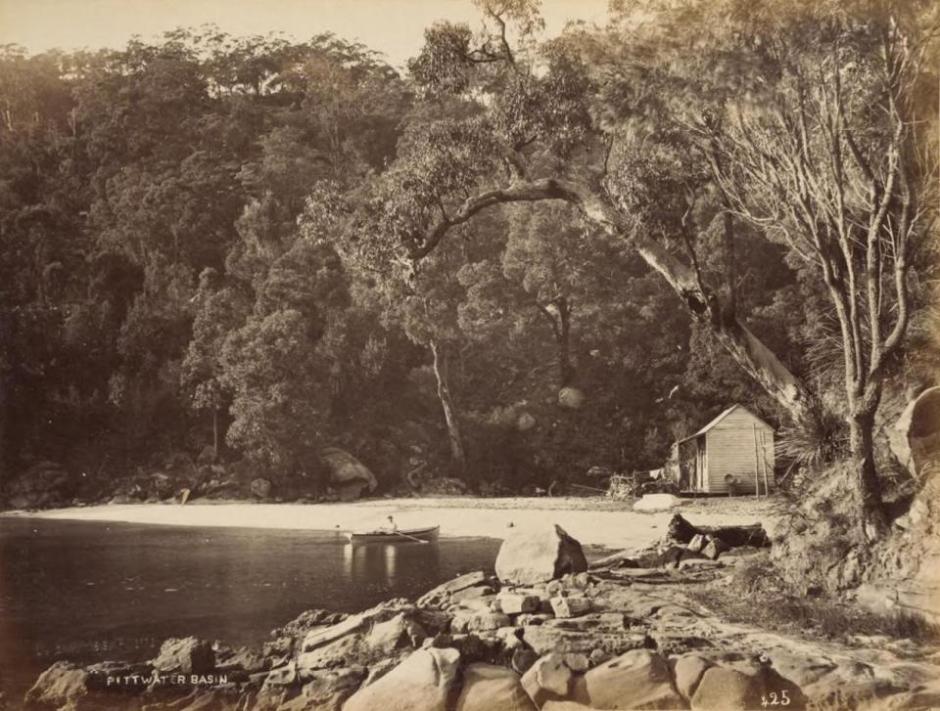
Rowboat at Pittwater Basin, New South Wales, circa. 1880 by Charles Bayliss, Image No.: nla.pic-vn4277873, courtesy National Library of Australia.
The only place you can camp in Ku-ring-gai Chase National Park is at The Basin, accessible by walking in after parking at West Head Road or by water taxi, boat or the ferry departing from Palm Beach Wharf. The online world now means people can take a virtual tour of The Basin campground captured with Google Street View Trekker Find out more or Book on the National Parks and Wildlife Service page here
Recent images added into TROVE from photographs taken in 1903, adding to sketches found from 20 years prior to this and run in an early history page, A Tent at The Basin, along with sketches by John Hoyte from 1883, one of the Royal Art Society founders in Sydney, in an article 'A Glimpse of the Hawkesbury', another of 'Blind Cove' from the same year, repeat the message that The Basin has always been a place to camp, whether in a tent on the shores or in a boat moored in these sheltered waters.
The photographs from 1903 feature Mary Ann Morris, also known as 'Sally' or 'Peggy' of The Basin. Mrs. Morris is reported to have resided at The Basin from 1868 on, and as such, allows us to see the face of one early Pittwater resident during the eras when photographic records were taking over from artistic or scientific sketches as a means to allow people to see places and persons at a distance.
Jim Macken's excellent 'Sally Morris...of the Basin' , published 2001 and reprinted 2006, allows a more comprehensive record to be accessed and has been referred to in putting this page together.
With the finding of these to add to a growing collection of historic The Basin resources, the placing of these on one page allows a small celebration of this still beautiful place at a time of the year when many of us seek these peaceful offshore areas for hours of respite from the fast and full days of summer and autumn.
In one of those quirks of a similar history repeating itself, the mid-1930's fracas over closing the Inner Basin off to vessels mooring there, which had occurred since the late 1880's, was echoed by another kind of netting and the destruction that caused:
THE BASIN. PITTWATER.
Net fishermen long ago killed the Basin as a whiting and bream haunt of repute, but outside it the fish are still occasionally caught. This is one of the first places near Sydney whence the whiting used to be reported, and it is still possible before the netters get to. work, and in the deep water beyond their limit, to snare a few of the tasty fish. At the entrance to the Basin in times gene by splendid hauls used to be. caught. . . THE BASIN, PITTWATER. (1906, August 29). Referee (Sydney, NSW : 1886 - 1939), , p. 11. Retrieved fromhttp://nla.gov.au/nla.news-article120326946
The closing off of the Inner Basin and the debate that proceeded it, all published in periodicals of those months, that begins with the idea of a shark-proof net (Pittwater had a lot of shark visitors during the first half of the 20th century) and ends with the installation of a shark-proof net:
INNER BASIN, PITTWATER.
In a letter to the Editor of the "Herald," Mr. A. C. Cooke appeals to yachtsmen to oppose the reported decision of the Kuring-gai Chase trustees to close the Inner Basin, Pittwater, to all boats, irrespective of size, in order that they might convert the basin into a huge swimming pool, protected by a sharkproof net. INNER BASIN, PITTWATER. (1934, November 6). The Sydney Morning Herald (NSW : 1842 - 1954), , p. 10. Retrieved from http://nla.gov.au/nla.news-article17130565
INNER BASIN, PITTWATER.
The objection raised by yachtsmen to the Kuring-gai Chase Trust's proposal to close the Inner Basin, Pittwater, against yachts and launches, and to reserve it for the exclusive Use of bathers, evoked the reply from the trustees that they had been driven reluctantly to consider such a proposal by the action of yachtsmen themselves. The basin is almost entirely enclosed, and there is practically no scour by the tides. Sanitary conveniences have been provided on shore by the trustees, but, it is stated, the obvious requirements of the situation have been ignored by most owners of craft using the basin. The result has been to create within the pool so serious a nuisance that the only alternative appears to be the closing of the basin altogether. Before reaching a final decision, the trustees intend to confer with the committee of the Pittwater Yacht Club. INNER BASIN, PITTWATER. (1934, November 12). The Sydney Morning Herald (NSW : 1842 - 1954), , p. 4. Retrieved from http://nla.gov.au/nla.news-article17138900
MOTOR. BOATING. PITTWATER REGATTA PROTEST
At a largely attended meeting of the Pittwater Regatta Committee representing all sections of aquatic snort a resolution was passed on Monday night protesting against the proposal of the trustees of the Kuring-gal Chase to close the Inner basin at Coaster s Retreat Pittwater.
It was stated that for upwards of fifty years the Inner basin had been the rendezvous of all types of yachtsmen and that It was one of the few spots left entirely unspoilt by the trend of modern development Members of the committee «reed that It should not be Interfered with but left In Its natural state for the benefit of present and future generations
The meeting decided that representation should be made to the trustees to present this unwarranted action of converting the Inner basin into a swimming area and thus depriving yachtsmen of the right to use It. MOTOR BOATING. (1934, November 14).The Sydney Morning Herald (NSW : 1842 - 1954), , p. 18. Retrieved from http://nla.gov.au/nla.news-article17115736
INNER BASIN, PITTWATER.
TO THE EDITOR OF THE HERALD.
Sir -My attention has been drawn to a paragraph In your paper under the heading of "Inner Basin Pittwater wherein the trustees of Kuring-Gai Chase state The basin is almost entirely enclosed and there is practically no scour of the tides Sanitary conveniences have been provided on shore by the trustees but it is stated the obvious inquirements of the situation have been ignored by most owners of craft using the basin. This is not according to fact, as the number of craft moored for any length of time within the basin except for Christmas, Easter and a few holidays Is negligible. If there is trouble it Is caused by the action of the trustees in locking up their conveniences and only making them accessible on placing a coin in a slot in the locked doors which yachtsmen are not always in a position to comply with
At times large parties arrive by ferry from Brooklyn and picnic parties by hired launches and through lack of change or disinclination to pay at times may cause some trouble Yachts have properly constructed conveniences and boats of any draught cannot enter the basin except at high tide During the summer, when the strong nor-eastern blow The boats lying outside find it difficult to land with their dinghys and they then enter the basin and land at the wharf. At times small boat owners with ladies aboard go inside to avoid the jobble.
The real trouble is the baths where the trust deposited a mass of spoil removed from the erection of a reservoir and made a barrier that destroyed the natural scour of the tide that used to clean out the baths. The way to deal with this matter is not to deprive the public who use the basin all the year round for the few swimming parties who would use it occasionally but rather to deal with the entrance by enlarging it so that the scour will be increased It is to he hoped that nature lovers and yacht owners will yet Induce the trust to desist in their contemplated action. Sydney Nov 13 YACHTSMAN. INNER BASIN, PITTWATER. (1934, November 15). The Sydney Morning Herald(NSW : 1842 - 1954), , p. 3. Retrieved from http://nla.gov.au/nla.news-article17140873
INNER BASIN. PITTWATER.
TO THE EDITOR OF THE HERALD.
Sir,-Further to my letter of the 5th instant, and also to the reply of the trustees in this morning's "Herald," I would point out that in my opinion, and also that of many yachts-men, the lack of scour in the baths in the Inner basin has been considerably aggravated by the removal of the old wooden jetty and the substitution of a stone jetty, thereby acting as a breakwater and preventing the natural scour.
In regard to the trustees' statement, that the only alternative appeals to the closing of the basin altogether may I suggest that there is still another one, and that is to erect a shark-proof fence along the little beach which is on the southern side of the enhance and continue same to the stone jetty which would form the south-eastern side of the baths, and would give a certain amount of shelter as well as strength to the fencing Incidentally, this beach, although open at present, is used a good deal by swimmers.
The advantage of the above would be that the baths will be open to the full scour of the tides, winds, etc, and, m addition, yachtsmen will still have the advantage of the very safe and peaceful anchorages available in the inner basin
I am, etc., A. C. COOKE. Civic House, Nov. 12. INNER BASIN PITTWATER. (1934, November 19). The Sydney Morning Herald (NSW : 1842 - 1954), , p. 5. Retrieved from http://nla.gov.au/nla.news-article17113594
THE BASIN, PITTWATER.
Mr. A. D. Walker, commodore of the Royal Motor Yacht Club, Broken Bay branch, said yesterday that opposition was being expressed to the proposed closing, by the Kuring-gai Chase Trust, of the Basin, Pittwater. More than 200 yachtsmen and their crews attended a meeting of protest, and a petition had been sent .to the Minister for Lands. Many public bodies, and aquatic clubs had expressed opposition. He had received copies of many letters sent to the Minister, objecting to the trust's proposed action.
Mr. Walker said that during the Christmas holidays his club appointed a committee to investigate statements made by Mr. Orchard, chairman of the trust, about yachtsmen polluting the Basin. It found that the allegations were Incorrect, and that large parties were swimming in the baths without complaints of any kind. The committee discovered that the trust granted permits for a number of well-conducted camps on the flat, for which It charged 5/ a tent a week. THE BASIN, PITTWATER. (1935, January 8). The Sydney Morning Herald (NSW : 1842 - 1954), , p. 10. Retrieved from http://nla.gov.au/nla.news-article17137390
THE BASIN, PITTWATER.
The president of the Kuring-gal Chase Trust, Mr R B Orchard, replied yesterday to Commodore A D Walker's criticism of the trust’s proposal to close The Basin Pittwater.
Mr. Orchard said that the Inner basin was a confined area, only accessible by a narrow passage and during certain periods of the tides The baths were located in the Basin. At times as many as 75 launches were anchored in the basin The trust had found that the presence of the yachts was the cause of pollution of the basin The fault wan not that of the trust. It had made provision for the needs of the large number of people but the accommodation it had provided had not been utilised.
Mr Orchard said that some people had contacted skin diseases as a result of bathing in the baths, and the only inference was that the baths were being polluted. The proposed bridge would not prevent pleasure-seekers In row boats or small launches from visiting the Inner Basin It would only exclude certain larger craft which anchored there. THE BASIN, PITTWATER. (1935, January 9). The Sydney Morning Herald (NSW : 1842 - 1954), , p. 8. Retrieved from http://nla.gov.au/nla.news-article17114220
INNER BASIN, PITTWATER.
At yesterday's meeting of the Kuring-gai Chase Trust the protest against the proposed closing of the inner basin, Pittwater, to large craft was discussed. It was decided to ask the motor boat and yacht clubs, whose members use the Inner basin, to assist the trust to obviate the nuisance and danger to health caused by the pollution of the waters there. INNER BASIN, PITTWATER. (1935, January 11). The Sydney Morning Herald (NSW : 1842 - 1954), , p. 12. Retrieved from http://nla.gov.au/nla.news-article17122428
PITTWATER BASIN. Conference Called.
In the hope of securing an amicable settlement of the dispute over the proposed closing of the inner basin at Pittwater, the Minister for Lands (Mr. Buttenshaw) has arranged a conference of the interests concerned. It will be attended by three members of the Kuring-gai Chase Trust, and one representative each from the Royal Sydney Yacht Squadron, the Royal Motor Yacht Club, and the Pittwater Basin Defence Committee, with the Minister as chairman.
The secretary of the Pittwater Basin Defence Committee (Mr. D. White) said yesterday that although he and other members of the committee opposed the Trust's scheme they realised that the trustees were acting in good faith. PITTWATER BASIN. (1935, January 19).The Sydney Morning Herald (NSW : 1842 - 1954), , p. 12. Retrieved from http://nla.gov.au/nla.news-article17128236
PARKS AND PLAYGROUNDS. Pittwater Basin Discussed.
The Parks anti-Playgrounds Movement yesterday decided to co-operate in any solution of the problem of the alleged pollution of the 'Pittwater Basin, and to ask the trustees of the area to preserve and perpetuate the primitive beauty of the Basin.
The chairman (Mr. A. J. Small) said motor, boat owners and yachtsmen should suggest how the nuisance might be abated. There was no doubt that pollution occurred.
Mr. D. White (Pittwater Basin Defence Committee) said that the Basin was a refuge for yachtsmen and others, and the committee was opposed to its closure as suggested by the trustees. He understood that petrol pumps were to be erected, and Norfolk Island pine-trees were to be planted in the area, and his committee opposed that spoliation of the primitive beauty of the foreshore.
Mr. D. G. Stead said that, while pine-trees were very beautiful, they would be out of place at the Basin. PARKS AND PLAYGROUNDS. (1935, February 14). The Sydney Morning Herald (NSW : 1842 - 1954), , p. 5. Retrieved from http://nla.gov.au/nla.news-article17160432
The Royal Prince Alfred Yacht Club and Royal Motor Yacht Club (Broken Bay - at Newport) - have long made The Basin a favourite place, with The Basin Cup beginning before 1906 - the year of the first 'Pittwater Regatta'. The Basin, Pittwater and adjacent 'creeks' and bays have long been sort by those going 'cruising' during the Christmas-New Year's break, as these early yacht clubs of Sydney Harbour demonstrate:
CRUISING AT BROKEN BAY
From all the various amusements excursions heralded by more or less enticing announcements we may perhaps turn aside and give a short record of our yachtsmen and boat sailors who, whenever three or four days can be gained, invariably steal away along some 17 miles of open sea, and make Broken Bay a second Port Jackson. Tuesday morning the first of a fleet of 25 boats, or 20 excluding yachts, started with a fresh south-west wind, and arrived at midday under Barrenjoey, where boats generally send a wire back to Sydney announcing a late arrival. This was the Wanganella. On Wednesday evening she was joined by the Muriel, Pleiades, Iris, and Corinne. The Waitango arrived at midnight Wednesday, and before noon on Thursday the Maritana, Dreamland, Lottie, Snowdrop, Weringa (Mr. Charlton), Viking, Curlew, Cutty Sark, Asteroid, Pearl, Sibyl, Agnes, Zuluiku, Psyche, Colleen Bawn, had sailed round; while on Friday the Violet, Mistral, and Sao arrived. Besides these, which sailed lound, muuv brought skills on steamers, which ensures a camp, if winds are not suitable for sailing round. However, fortunately, the wind was fair both ways, and the sea for the most part smooth, with a fair swell.
If any boats have been omitted from this list it is because they were not seen among the more popular haunts; but as it is, it may be taken as showing; that our Sydney amateurs have learnt something practical as well as racing in smooth water, as the fastest boats we have of all the lengths 20 feet and over prove themselves quite safe outside with pleasure sails.
Crews of two up to six or seven seemed to be the usual party, while the smallest boats were the Iris, 10 feet, aand Cutty Sark 20, Corinne 21 feet, and others, as will be seen from the list. From Beroura Creek, some 20 miles or more up, down to Pittwater, and between those places, Cowan Creek, Wagonga Creek, and the now-famous rendezvous, the Basin, boats covered in could be seen.
The weather was very cool, but the wind very unsteady and shifting. Fish did not seem very plentiful. On Saturday evening most of the boats came down the river to the Basin, where there were 12 boats and three yachts at anchor; in fact, nowhere in Sydney harbour was there ever such a fleet of boats and boating men as occupied the bay that evening.
On Sunday morning, from daylight until noon, the boots began to drop down to the Heads, the Cutty Sark getting away at 6 a.m., and must have been one of the first back. About noon, when the sea breeze was well set, there wore 11 boats, not counting yachts, between North Head and Broken Bay-a long line right up the coast. The Dreamland and Wanganella happened to jibe round Barranjoey together, and were about 12 minutes apart at North Head ; and there must have been other pairs of boats on the way down pretty well matched. By 2 in the afternoon all except one or two were back, some going to Manly to dine, and others coming straight down to their moorings. CRUISING AT BROKEN BAY. (1884, December 30). The Sydney Morning Herald (NSW : 1842 - 1954), p. 8. Retrieved from http://nla.gov.au/nla.news-article28365019
Visit The Basin
CRUISING IN THE HAWKESBURY.
It has often been said that our aquatic amateur sailors were unequal to the task of venturing outside the Heads; but the number who have gone out during the holidays, to explore "fresh fields and pastures new," both north and south, completely disproves any such statement, and the only reason that those extended cruises do not occur oftener is because it is useless going outside unless one has at least three days to spare from business. The beautiful waters of the Hawkesbury had representatives from the different sailing clubs. The S.A.S.C. and the D.B. A.B.C. were in great force. Commodore Dietrich, Commodore M'Donnell, Vice-commodore Milson (Waitangi), and the Vice-commodores of the P.A.Y.C. and D.B.A.S.C., all went up in their boats, thus setting a good example to the other members and bearing silent testimony that we have a nucleus of at least one hundred well trained boat sailors. Exclusive of five yachts there were at least 20 boats counted about the bays in the Hawkesbury, all of which sailed out from the" Heads from Tuesday to Thursday morning. Camping out is now held in high favour, and becoming- even quite fashionable, and this too by persons owning boats that hitherto have been looked upon as mere racing machines. The Sydney Amateur Sailing Club was represented by the Asteroid, Dreamland, Lottie, Snowdrop, Muriel, Cutty Sark, Wanganella, Psyche, Colleen Bawn. The Double Bay A. Sailing Club by the Curlew Iris. The Lottie being also the commodore's boat of the other club. Besides these, there were- also present1 then} Viking, Mr.. Charlton's new boat, the Weringa, Pearly Sybil, Agnes, Zuleika, Corinne, Maritana ; the latter having made a very fast trip from Sydney. The weather was very favorable both going and coming. In going down there was a good muster on Thursday morning, some ten boats going out in close order. Some had gone on Wednesday afternoon and one on Tuesday morning.
The time made was very good both ways. A capital opportunity was given to Beat the river, as there was a fine S.E. wind and flood tide, and the majority made their way as far as Beroura Creek which was honoured by the Dreamland,. Lottie, Wanganella, Curlew, Zuleika on Christmas Day; while just below were the Waitangi and Muriel, with the Pleiades and Viking in Cowan Creek. Some boats, anchored in Wogonga Creek, the Asteroid was lying very lonely under Long Island; and some three or four others went over to Pittwater and the Basin. On Friday most of the boats worked lower down the river, and in the sea reach the Violet, Mistral and Sao, were met coming from Sydney; followed by the Wolverene, which, if report be true, found amusement and instruction in shelling the banks of Cowan Creek, and thereby setting fire to the bush and so disfiguring nature. Certainly from the basin reports were heard, and soon after bush-fire smoke was seen moving in clouds.
On Saturday evening there was a large muster at the Basin, 12 boats and three yachts laying there waiting for the return trip on Sunday. Punctually at & p.m. the Waitangi, the flagboat, of the fleet, fired her cannon; which is repeated at 8 a.m., when the flag is hoisted.
At night the scene on shore was very lively, as most of the-crews had mutual friends, and told various yarns of their aquatic experiences, and it was pretty late before the various crews turned in except for those who were going out with the early westerly at daylight.
The Cutty Sark left the basin first, followed by the Snowdrop, Pearl, and the Young Harry, a fishing boat from Double Bay, hired by some amateurs. These three got well off the land by 10a.m.; but found the E.N.E, very late in coming in. Soon after the Dreamland and Wanganella, with the Sibyl, from the river, put out, getting an offing about 11 a.m. The Dreamland came back very fast, catching the Pearl, which had a long start of some two or three miles, and beating the Wanganella by some 12 minutes. When Long Reef was reached, the scene would have made a very pretty picture. There were six boats in a heap astern or the Wanganella, and four ahead, with some yachts bowling along at a fast pace. The trip took from two and a half to three hours, and more for slower boats, from Barrenjoey to South reef, and the wind was not too much aft to stop the jib from drawing. The Curlew, Iris, Colleen Bawn, stayed behind, and perhaps others, but all the rest, so far as we can learn, reached home safely without accident.
The fair wind did not necessitate anyone having to overland it from Pitt Water to be in time-for business. Besides the sailing boats, there were numerous skiffs taken round by steamer, and the two steam yachts Eva and Northumbrian steamed up. What other ports were visited by the club's and other boats will, doubtless, be duly recorded; but for Broken Bay it may be said that it had the lion's share, and it is gratifying, to know that when such an occasion as this just past offers itself our amateurs are only too glad to vary the monotony of the smooth harbour for a lurch and a roll on our own sunny ocean. CRUISING IN THE HAWKESBURY. (1885, January 3). Australian Town and Country Journal (Sydney, NSW : 1870 - 1907), p. 38. Retrieved from http://nla.gov.au/nla.news-article71021899 :
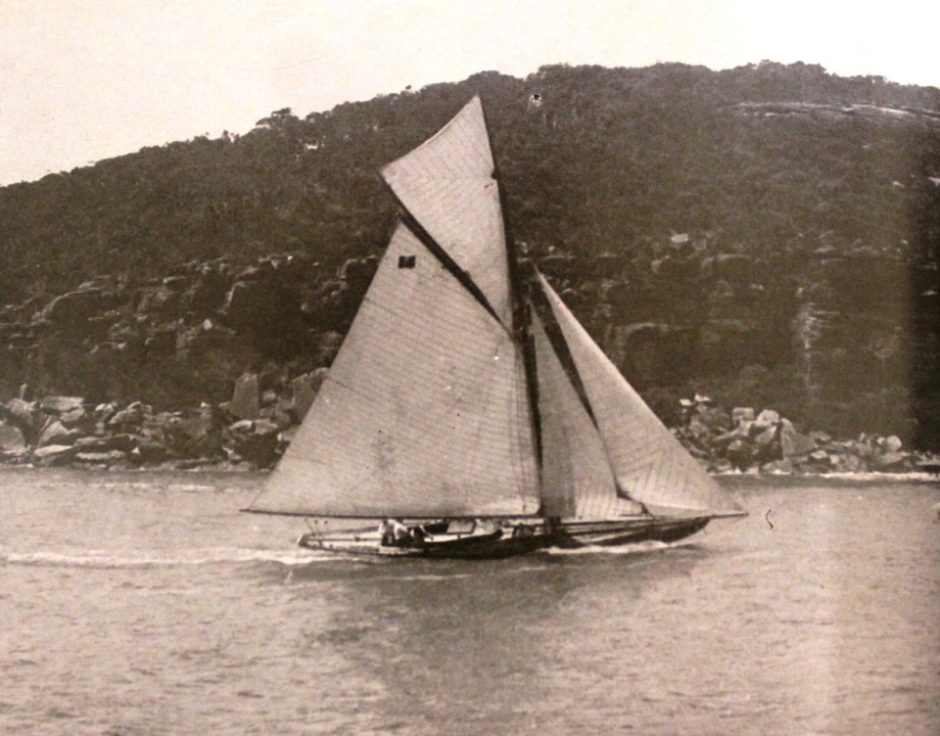
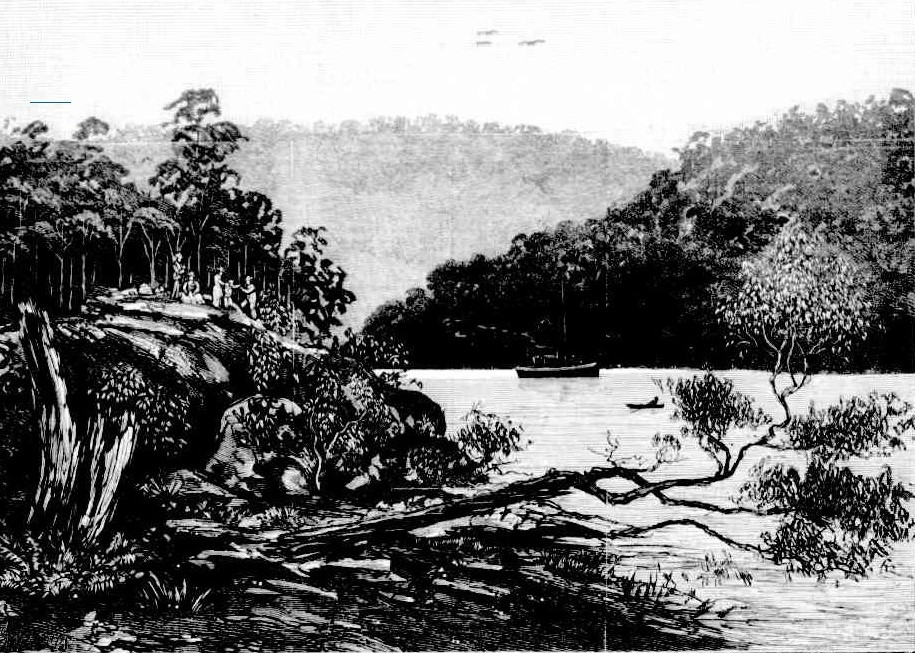
Blind Cove, Pittwater, N.SW. This beautiful little bay shown in our illustration, formerly private property, has been made a reserve of by Government, and is now practically a cruising1 ground for the yachting community of Sydney. A more useful and delightful sheet of water could not have been chosen, situated as it is at the entrance to the Hawkesbusy River, just opposite Barrenjoey. To the north is the broad expanse of water known as Brisbane Water, and to its south Pittwater, which is now connected with Sydney, Newport, and Manly by means of a coach running daily. Blind Cove, also called The Basin, is a safe refuge in the very worst of weather. It owes its name of Blind Cove to the fact of its being invisible to the incomer until he has almost reached its entrance, which is very narrow and hidden from view by a low stretch of sand ; but inside this narrow passage there is deep water, and the height of the hills surrounding the basin (some 600 feet) so thoroughly shelter it from heavy winds that it might well be called Looking-glass Bay. It is on account of this, and also the beauty of the surrounding scenery, that has made it one of the principal rendezvous of yachtsmen. Blind Cove, Pittwater, N.SW. (1883, March 10).Australian Town and Country Journal (Sydney, NSW : 1870 - 1907), p. 26. Retrieved from http://nla.gov.au/nla.news-article70996783
A Glimpse of the Hawkesbury.
By Francis Myers.
ILLUSTRATED BY J. C. HOYTE.
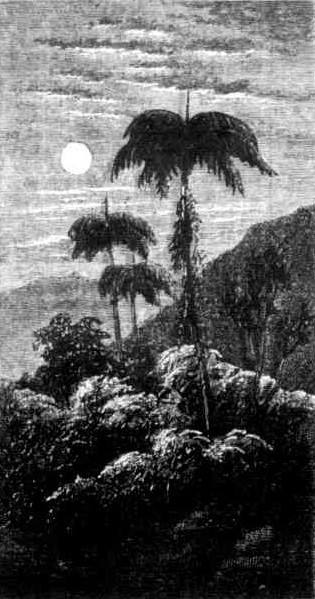 That blue glimmer of electric light along the quay gleams as the entrance of an infernal city, and the red lights above beam as the eyes of a thousand devils, and the smoke goes up as the smoke of a place of torment; for we brain-wearied workers, who have been ground in its mills for many months, are flying away to rest. Yes ; to rest amongst the cool sea spaces and the nodding caps and the sleeping islands and the majesty of beauty and the blessed peacefulness and quiet of that larger heaven within the heads of Broken Bay.' We travel by Manly, and a short hour's journey brings us to that fair suburb. From Manly, by the primitive old coach, to Pittwater. Horses rough, harness rough, coach shaky, road bumpy; still, however rude, right pleasant work, for the great white Easter moon floods all the land with silver sheen and mystery. The low hills rest like sleeping creatures with folded wings, the still lakes are as great glassy windows through which spirits of the inner world might peep at the outer glory, here and there stands a tall palm as a sentinel, and rounding headlands by the open sea the murmur of the waves come up as of a million sea doves cooing through their dreams.
That blue glimmer of electric light along the quay gleams as the entrance of an infernal city, and the red lights above beam as the eyes of a thousand devils, and the smoke goes up as the smoke of a place of torment; for we brain-wearied workers, who have been ground in its mills for many months, are flying away to rest. Yes ; to rest amongst the cool sea spaces and the nodding caps and the sleeping islands and the majesty of beauty and the blessed peacefulness and quiet of that larger heaven within the heads of Broken Bay.' We travel by Manly, and a short hour's journey brings us to that fair suburb. From Manly, by the primitive old coach, to Pittwater. Horses rough, harness rough, coach shaky, road bumpy; still, however rude, right pleasant work, for the great white Easter moon floods all the land with silver sheen and mystery. The low hills rest like sleeping creatures with folded wings, the still lakes are as great glassy windows through which spirits of the inner world might peep at the outer glory, here and there stands a tall palm as a sentinel, and rounding headlands by the open sea the murmur of the waves come up as of a million sea doves cooing through their dreams.
A FEW TALL PALM TREES STAND AS SENTINELS.
High shorelands sink to shelving braches, and there through the weird water the pink sand flushes, as the cheek of a young Endymion to the kiss of the lady moon. Still tearing along with wboop, and halloa, and much persuasion to the tired horses, and by a quick turn upon a sidelong track into woodlands high and dank and dewy, all dark below save for the glimmer of a few white starry flowers, but fringed with silver aloft, for it is midnight, and the moon is in mid heaven. And 'twere well if we could all go to heaven for an hour or two, for the mundane aspect considered in mundane fashion is not inspiriting The journey is ended, and from a grim house comes a grim custodian, gaunt and churlish. House, man, and furnishings all much alike — better forgotten, o-better, perhaps, fixed in memory as things seen upon the shores of that lovely water in the Easter of 1883. What will it be in '93? Certainly it will not be fairer than it appeared at the very earliest dawning of the following day. Look outward and be happy, for the sunrise has not yet lipped the hills. The lovely purple uncrowned by one single gleam of gold deepens to indigo upon the edge of the water, which in its centre reflects the gray of the sky and the dying lights of some few pale twinkling stars. The birds are piping timidly as fearing to break the solemn hushfulness.
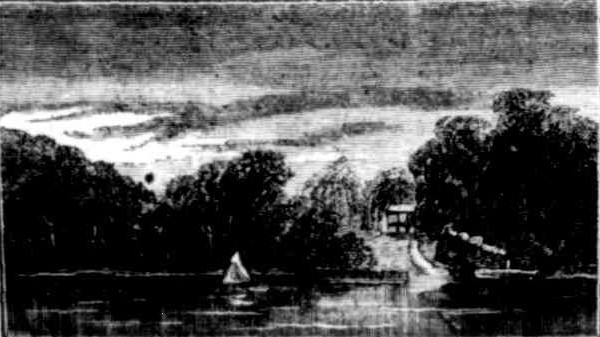
NEWPORT BASIN.
The tall trees hold every bough and branch and tiniest leaflet motionless. Only the blue mist quivers waiting, waiting — and suddenly, swiftly as the unfurling o1banners at a trumpet blast, a red light flashes on the high clouds to the westward, and the blue mist is burned up, and the glassy face of the water is broken, and the mystery of beauty of the dawning is thrust out of the world be for the glorious majesty of the day. The day spreads his livery of gold and brightness upon All the hills. The day smites the inner waters and the outer deeps with his strong hand and the white caps leap and flash, and the surges ring upon sand and rock. But very soon that white sail we are awaiting comes stealing, floating, gliding on, compelling the little fluttering breeze to her will, straight up the mid channel and round with a flutter of canvas abreast the narrow space of half civilized shore. And quickly we are on board and at rest.
There is no rest in the world to compare with that perfect abandonment, that absolute repose which comes with the idle lap of water against the vessel's sides, the near shores drifting backwards, a new heaven and a new earth perpetually opening ahead. At noon that autumn day we sailed into ' The Basin 'and dropped anchor. Ten years hence the article will be qualification enough for that basin. It will be no more necessary to ask what basin than what queen when Englishmen stand together to do allegiance. There are beauties enough within our own harbour gates, but they areas tiny pearls to an emperor's crown-jewel when compared with this. Here is a deep, still pool, a Constance, a Leman, a Katrine filled twice a day with the vigour and freshness of the strong sea tides.
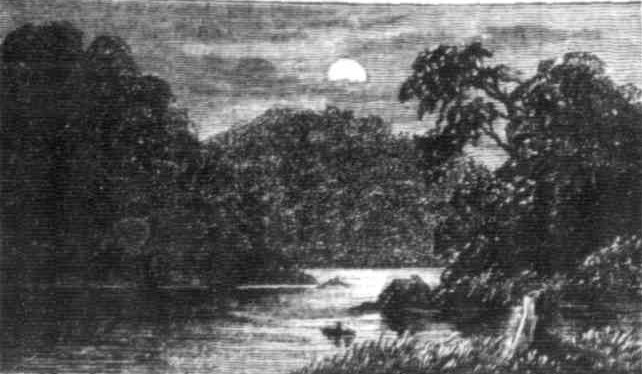
THE INNER BASIN.
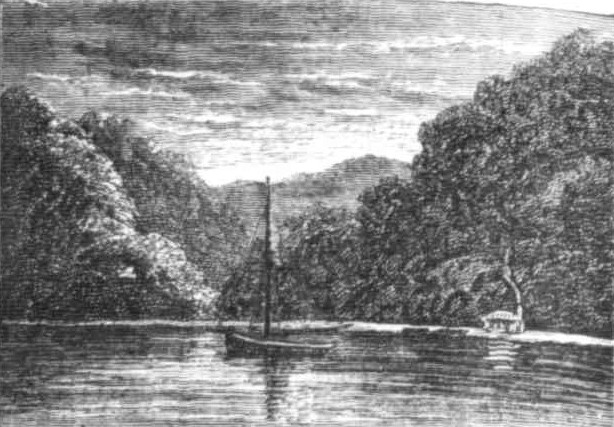
THE OUTER BASIN -MARY ANN'S HUT.
Round Barrenjoey comes the swirling rush, rolling along the eastern harbour branch through the deep channel, washing the point of the sandspit, whispering on every beach, and lapping gently at the rocky base of every cliff, then resting for a quiet hour while the sun sets or the moon rises, and some few strange birds chirp contentedly in the forest. The hills, of a lordly size in the daylight, rise huge and vast when the moonshines. The great tree trunks below are scarcely perceived, but above, each leaf edge touched by the white light sparkles and gleams, and the waterfall sings louder through the dark, dank fern, and lazily-moving oars strike fire from the blackness that is barred from shore to shore by the long moon rays. Strange that no poet has sung of the mystery of the moonrise, the dawning of the night light. It is colourless but marvellously beautiful, a perfect revelation of all the divinity of form. 'What will the future show us about that basin's banks? Houses, homes, pleasure grounds, one of the chief playfields of the city ? It has marvellous capabilities. Room enough upon the promontory jutting out from cliff toward cliff for such an hotel as we have not yet seen in Australia, water enough, always smooth and still and pure, to give battle space for half-a-dozen warships, or to bathe a nation, and water that about three chains of stout sea- fencing would render absolutely safe against all sharks and finny monsters.
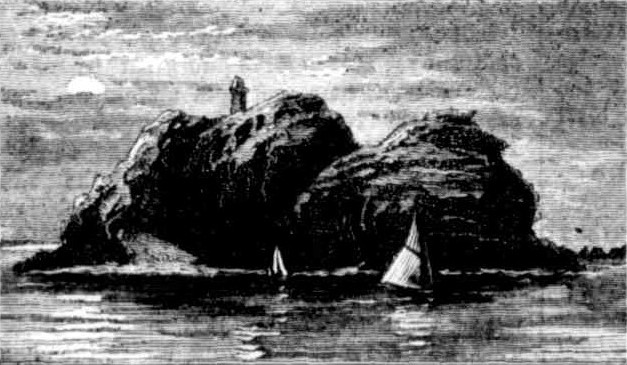
BARRENJOEY.
Now, a yachtsman's cottage and a fisherman's hut occupy the promontory, and for 11 months out of the year there is no more life or appreciation about the basin than about some lone tarn of the backblocks upon whose shore has been erected a boundary rider's hut. Morning brings us a dip in the lazy rollers upon the sand, a splash beneath the fresh water, raining from the ferns, a great breakfast of the black bream that swim into the fish-trap, poor foolish creatures, innocent and trustful as if their home were a thousand miles from any dwelling of man. Noon sees white wings spread again, and a further flight towards undiscovered beauties. Seeking the true Hawkesbury, we beat down abreast of the Heads, past the long sandspit coupling Barrenjoey to the mainland, regarding with much interest the huge,
grim, wave-washed, time-worn crag that lacks but around tower and a romance to fetter it to the hearts of a people. It bears a lighthouse useful to the mariner, but only vexatious to the dreamer. Wild and strong and stern frowns that rock with the sea foam at its base and the few sparse wind-tortured trees about its bead. It should have memories other than those of lamp- trimmers' yarns and convicts' jeers and groans.
And Elliott Island, lying almost in mid-channel, is also an artist's rock, so strangely shaped as to be capable of any comparison ; a lion couchant, a headless sphinx, a remnant of some giant's work of the world's strong youth worn down to vast indistinctness by winds and waves. Ah ! let us recall one evening when moored off the west head, the island and the rock, with every distant point, and all the dome of Heaven and the spaces of the sea, were seen transfigured and glorified by the out breathed spirit of a dying day. A thunderstorm had rolled over and lay upon the eastern bar and light from the clear inland western sky smote all its breast with fire. Some little shreds of cloud in midheaven let down a film of rain which bent the rays till they made bows upon the thundercloud, three separate trichord bands of light upon three points of distant land, an intense blackness below, and beyond a strange rich purple and greyness. Right out in the fore
ground Barrenjoey, his face as the face of an angry giant, every line, point, dent, and scar glowing as with the fire of an inward-born passion, and separated but by a silver band, the lovely Elliott Island cradled in blue water, fringed with the leaping foam, swathed in a silver haze that deepened to golden mist, end darkened too soon to a purple veil, all evanescent and beautiful as a dark proud woman's smile, and yet, thank God, in memory perpetual.
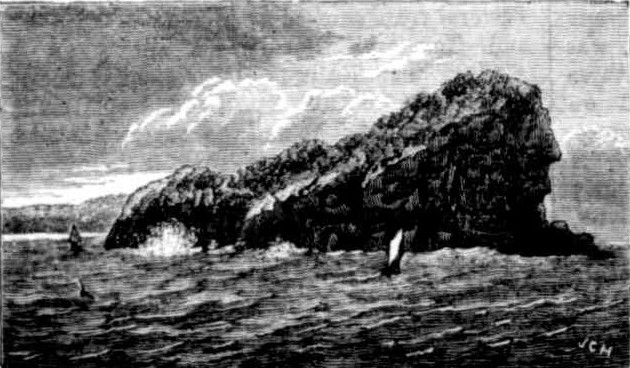
ELLIOTT ISLAND.
Round that West Head the river's mouth, or rather the ocean estuary, divides, and as we keep to the southern bank for a time the land is dreary, its monotony only broken by occasional fringes of sand and damp ravines, down which the waters flash, or trickle silently through wondrous mate of ferns, dense masses of luxuriant colour these ferns, showing every varying tints of tender green and rarest brown, the withered fronds above, dyed in the richest blood of autumn. But they are meanest details, thumbnail sketches in the great gallery. A merrier breeze pipes up from seaward, and in an hour we enter darker water, brown with all the silt of the big river, robbed of its beauty by the land stream and of its usefulness by the tide. A Glimpse of the Hawkesbury. (1883, April 7). The Sydney Mail and New South Wales Advertiser (NSW : 1871 - 1912), p. 640. Retrieved from http://nla.gov.au/nla.news-article162078253
These Illustrations would have been made from woodcuts or engravings.
A VETERAN ARTIST. DEATH OF MR. J. C. HOYTE.
By the death of Mr. John Clark Hoyte, which occurred at his residence, 141 Avenue-Road, Mosman, on Friday morning, the art world of Sydney loses one of its oldest identities. Mr. Hoyte was born in England in 1835, and received his early artistic training there, but some years of his early manhood were spent in the West Indies. Returning to England about 1860, Mr. Hoyte married, and shortly afterwards decided to go out to New Zealand, where some time after his arrival he joined the teaching staff of the Auckland Grammar School.
It was about this time that Mr. Hoyte's artistic work began to bring him into prominence. It was not long before he occupied a leading position in New Zealand art circles, and it is as a portrayer of the scenic beauties of the Dominion that he will be long remembered. Right up to the time of his death his work found keen appreciation there. About 1877 Mr. Hoyte left New Zealand, and settled in Sydney.
He was one of the founders and the first president of the Royal Art Society, among those associated with him at the time being Mr. A. J. Daplyn, the present secretary of the society. Of late years Mr. Hoyte had been but little before the Sydney art public. He was one of the old school, and found it difficult to adopt his ideas to the conventions of the newer artistic cult. The deceased has left a widow and two married daughters (one daughter having died some years ago), and several grandchildren and great-grandchildren. A VETERAN ARTIST. (1913, February 25). The Sydney Morning Herald (NSW : 1842 - 1954), p. 8. Retrieved from http://nla.gov.au/nla.news-article15400595
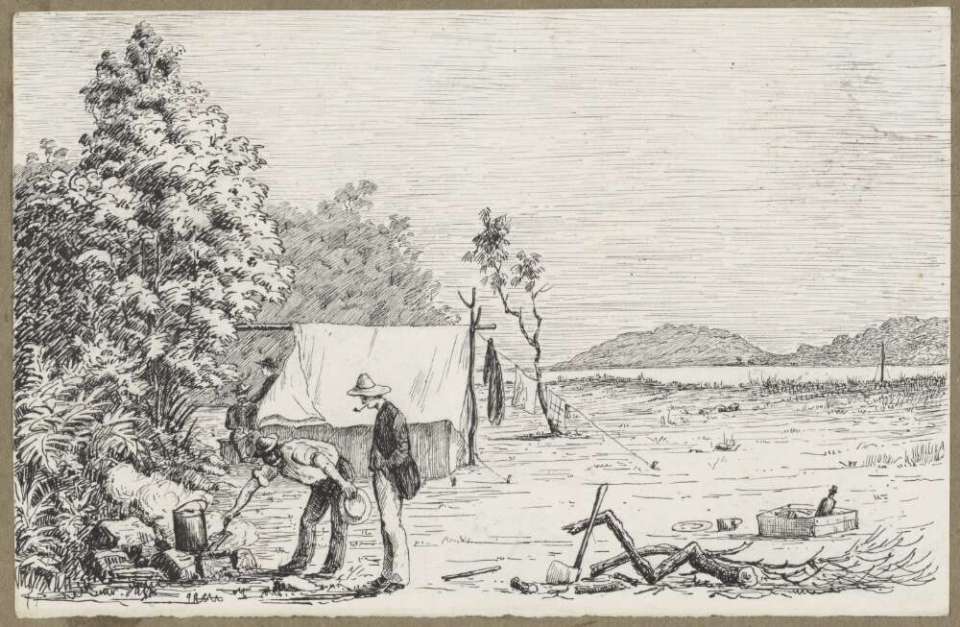
Our camp, the Basin, Broken Bay [picture] / [H.J. Harold John Graham]1858-1929 nlapic-an6438966, Courtesy of the National Library of Australia.
Below: Broken Bay 1884 or 1885, nla.pic-an6438962 Graham, H. J. (Harold John), 1858-1929, Courtesy of the National Library of Australia.
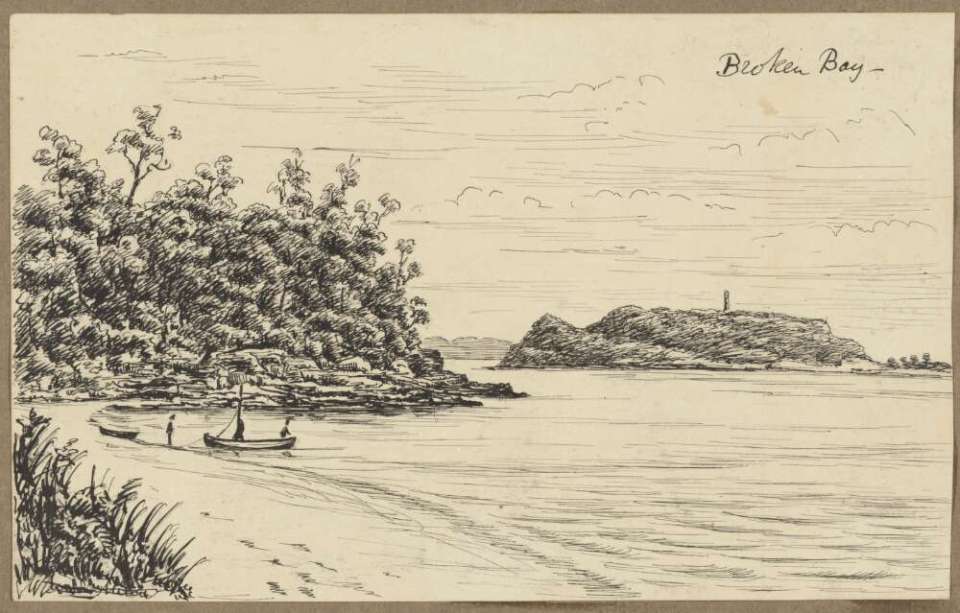
Hoping to recover from illness, Scottish-born Harold John Graham sailed to eastern Australia in 1881. A keen amateur artist, he recorded his observations of places and the local flora and fauna. He worked as a draughtsman in the Water Conservation Branch of the Public Works Department in Sydney. Retiring because of ill health, Graham together with his wife and children, returned to England in 1900. Source: Extracted from: Wrigley, J.W. (2013) Eucalypt Flowers, National Library of Australia, Canberra.
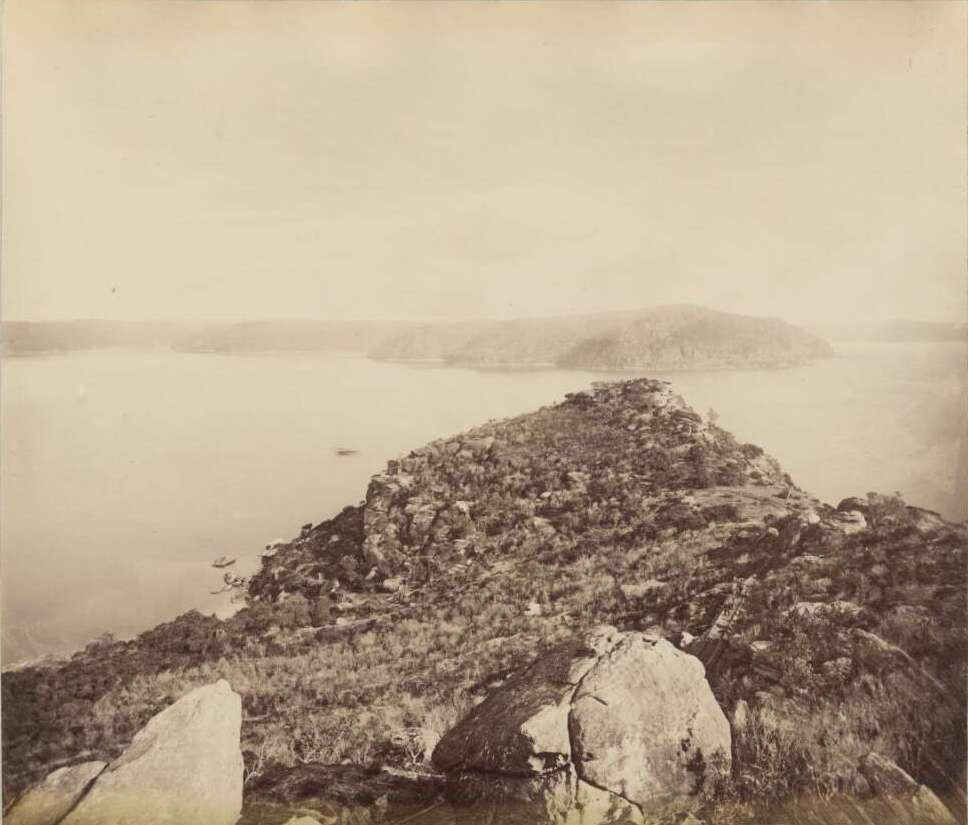
Broken Bay, ca. 1885, PIC/11442/17 LOC Album 91, courtesy National Library of Australia. Taken from Barrenjoey Headland
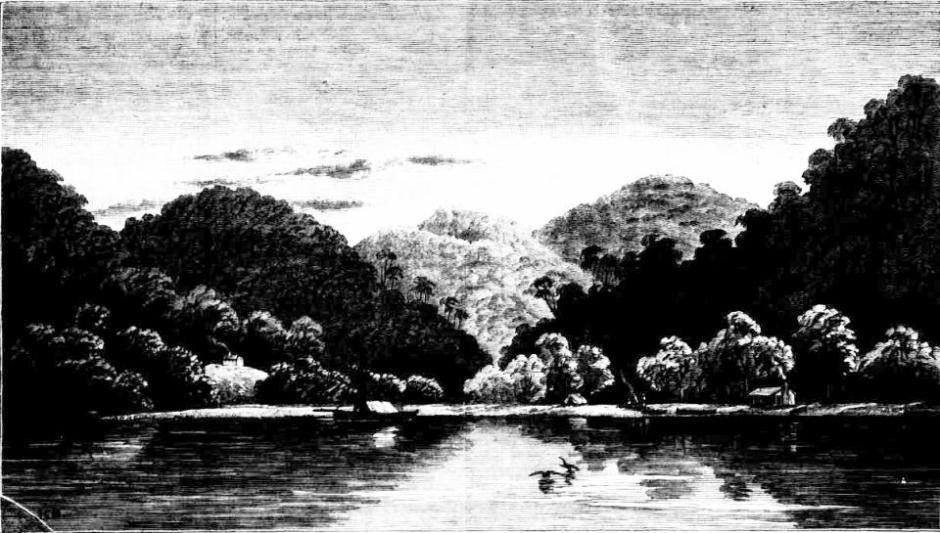
PITTWATER BASIN, HAWKESBURY RIVER. No title (1885, August 22). The Sydney Mail and New South Wales Advertiser (NSW : 1871 - 1912), , p. 400. Retrieved from http://nla.gov.au/nla.news-article162822900
A woodcut
In March 1891, the Drafting Committee (including Samuel Griffith, Edmund Barton, Charles Kingston and John Downer) revised the draft Constitution on board the paddlesteamer Lucinda when it anchored in The Basin. This 1891 draft later served as the starting point for the Convention of 1897-98.
Their stay at The Basin is commemorated by the Commonwealth Government by a plaque that remains installed in the sandstone wall of the shelter pavilion.
This states:
" On Saturday 28th March 1891 the Queensland Government paddle steamer, "Lucinda", cruised the lower reaches of the Hawkesbury River and anchored in the Basin. Work achieved on the vessel by colonial leaders, Sire Samuel Griffith and Messrs Barton and Kingston during that day and over Easter 1891 led to breaking the deadlock over contentious issues which eventually led to the adoption of the Australian Constitution. ERECTED TO COMMEMORATE THE EVENT BY THE AUSTRALIAN GOVERNMENT FOR THE COASTERS RETREAT HISTORICAL SOCIETY."
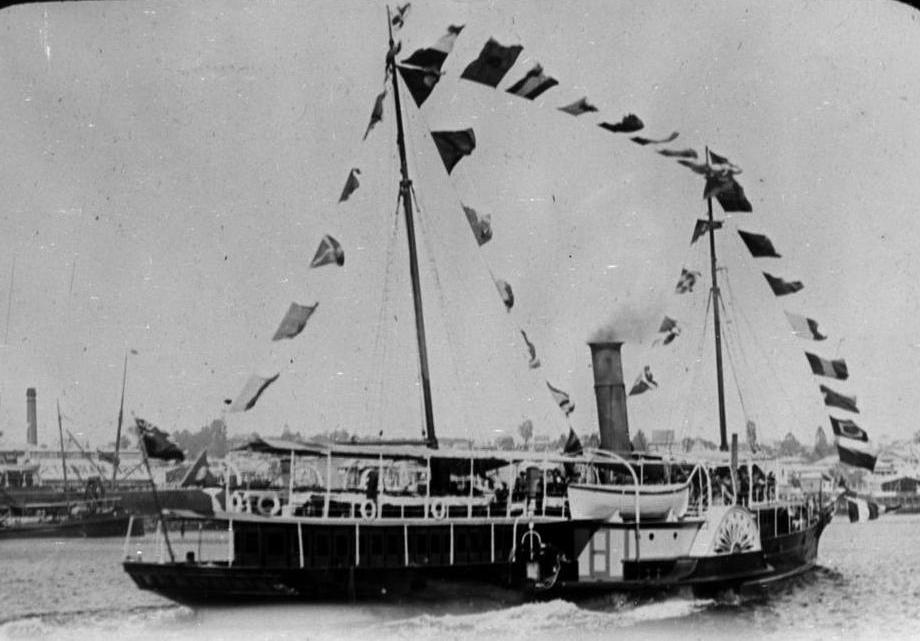
Festooned Lucinda cruising on the Brisbane River. Image No.: StateLibQld 1 270485, courtesy State Library of Queensland
The Federal Convention. DRAFTING THE CONSTITUTION.
The members of the Federal Constitution Bill Drafting Committee, at the invitation of Sir Samuel Griffith, on Friday night (March 27th) went on a cruise in the Queensland Government yacht Lucinda to Broken Bay and the Hawkesbury. The object of the cruise was to obtain absolute privacy and quietness for the work of drafting the measure. By dint of hard work the bill was drafted into shape late on Saturday night, and on the vessel returning to Sydney last evening, it was forwarded to the Government Printer. During to-day the draft will be considered by the constitutional machinery committee, and it is probable that the bill will be submitted to the convention to-morrow afternoon. The Federal Convention. (1891, March 30). Evening News (Sydney, NSW : 1869 - 1931), , p. 5. Retrieved fromhttp://nla.gov.au/nla.news-article114314795
The Queensland Government ordered Lucinda from the Scottish shipyard of William Denny & Brothers at Dumbarton in January 1884 to replace an earlier steam yacht Kate from 1864. She was designed as a paddle yacht and lighthouse tender with a steel hull of 180 feet length overall, 25 feet beam and 9½ feet depth; the steamer measured 301 gross registered tons and had a service draught of 6 ft 3in. Her two side paddles were powered by an oscillating two-cylinder compound engine of 114 nhp, made by Denny, and she was equipped with electric light. She had a female figurehead and her accommodation was well fitted out. The press reported that "Although technically designated as only as lighthouse tender, the Lucinda is in reality one of the most magnificent upholstered and effectively equipped steamers afloat." The forward saloon was fitted with sofas and could be converted to sleep 20 passengers, while the aft saloon was designed for social events. The specification notes that "an oval shaped deck opening in centre, with stained glass skylight, afforded light and ventilation" and that the "aft part of the deckhouse was fitted up as a ladies' ante-room, with side panels of japanese tapestry." There was also a smoking room in the forward deckhouse.
Lucinda was named in honour of Lady Jeannie Lucinda Musgrave (née Field), second wife of Governor Sir Anthony Musgrave. She was steamed out to Australia via Gibraltar, Suez Canal, Aden and Batavia, departing the Clyde on 17 January 1885 and arriving at Brisbane on 7 May.
As well as servicing Queensland lighthouses, the steamer was used for ministerial visits along the coast (and to New Guinea on occasion), Cabinet meetings on the Brisbane River and Moreton Bay, picnic outings for various associations and annual excursions for school children in the state. Lucinda was also flagship of the Royal Queensland Yacht Squadron, and she was referred to as Queensland Government Steam Yacht (QGSY) Lucinda.
NOTES ON THE CONVENTION.
(FROM OUR SPECIAL CORRESPONDENT.)
Was ever before, in the history of humanity, the constitution of a great nation fashioned on board ship? Those of smaller ones often have—by the captain of a man of-war. at the capstan head; and it is alleged the jovial rovers of the Spanish Main, whenever they descended on the Carribees, used to call a holy convocation of the best looking girls in the island, sometimes ashore, and sometimes, aboard, and amuse themselves by listening to the definition of the laws they would like to impose on all and sundry.
But, certainly, in causing the constitution of the Commonwealth of Australia-detestable phrase that latter—to be drawn up on board the Lucinda in—ominous suggestion—Broken Bay, Sir Samuel Griffith has established an astonishing precedent. Yet so it was. Ever since the Queenslanders have been in Sydney, their hotel has been their sharp-nosed, almost felucca-built trap, which has a curious sharpness of stem and clean lines, which excite general admiration, and their life there has been the envy of all who had to swelter by night in sultry Sydney. When the Convention adjourned, just before Eastertide, the constitutional committee rapidly adjusted the remaining points, and handed its duties over to its drafting sub-committee, who, with the exception of Mr Clark (Tasmania), who was indisposed from influenza, proceeded, at Sir Samuel’s invitation, aboard the Lucinda, and proceeded along the coast, drafting the Constitution in the intervals between sea-sickness and soda water.
Mr Clark, who is one of the ablest and smartest of the lawyers in the Convention, joined them on Sunday,.and the work was steadily pursued all through the Easter holidays, and reached its culmination on Sunday night. The constitutional machinery committee tackled the work boldly on the morning of Easter Monday, and sat until after 10 o’clock in the evening, when they were finally delivered of what is truly a magnum opus. That it will pass the Convention, of course, with some modifications, there is now little doubt, and every effort is being being made to close the Convention so as to have the final banquet about the 13th or 14th. The Western Australian delegates say that they have taken their passages from Adelaide by the steamer departing on. the 15th, and Mr Forrest their Premier, whose fame as an explorer who succeeded where most men failed is unique, says “get” he will. At Perth he has a young infant called Western Australia to nurse, and every.one knows that if you neglect a new born babe you are likely to “hear of it.” When I just changed cities I thought I should have been able to tell you much of the private views of the delegates to show you for what reasons the conclusions were arrived at to throw, in fact, side lights on the face of events. In this resp-ct the ground hag been cut from under my feet by the openness of the Convention.
The delegates express their own views—or so much of them as they deem politic—from their places, and it would be an impertinence, and cause confusion, after that to piece together the illustrative scraps of hints they drop in private or the pickings of the clubrooms and salons. Fur a like reason I have found it impossible to comment more upon the actual work done in Convention, for the wires flash such full particulars all over the colonies that it becomes the province of the leader writer rather than the political essayist to deal with these. One thing I have observed all along. The delegates met as men determined the foundation stone of Australasian unity should be cemented down this time, and it is not so much the words of their speeches, for politicians will quibble, but their tone that had to be taken into account. New Zealand will probably stand out; Western Australia and Tasmania may, though 1 scarcely think they will when the winning numbers are up, but you may rest assured the federation will be established, and as to Tasmania she cannot really help herself. If she held aloof now she would be dragged in in a year or two after the establishing of a federal tariff neck and heels. What is helping to bring about the fusion of the two most populous colonies is the feeling of pitying contempt the average Sydney freetrader has for the poor deluded Victorian, and his confidence that, once federated with him, he will make him realise the advantages of open ports to everybody so quickly that in a few years he will be throwing up his cap and crying “down with this protection against the world, freetrade with everybody.”
Only this morning the Sydney Morning Herald, throwing our Hayter in our teeth, assures us that while for 1889-90 our imports amounted to £24,492,760, our exports were but £12,734,734, leaving a balance of £11,668,026, which, it remarks, must be taken to be a portion of the 31 million odd by which we have increased our indebtedness during the last three years; while for the same period in New South Wales the import- were £22,863,057, and exports £23,294,934, or almost double those of Victoria. In the period from 1867 to 1889, 22 years, they point out the population of Victoria had increased from 651,571 to 1,115,025, while the value of exports of articles manufactured in the colony fell from £15 9s 7d to £8 17s Id per head, and the value of exports produced or manufactured in New South Wales, which in 1878 was £16 5s per head, was in 1888 £l6 4s 1d. After mercilessly quoting a few more leaves from Hayter, the article concludes with “such are a few of the gleanings from the second volume of the instructive Year Book, which the Victorian Statist annually publishes as a warning to the colonies and as a record of the results of the costly policy in an unlucky hour adopted by Victoria.” It has proved a little important for Victoria that Sir Samuel Griffith should have chosen as his principal helper on the drafting committee, Mr Clark, of Tasmania, instead of the conqueror of Ah Toy. At the same time there cannot be the smallest doubt but that the better lawyer was selected. Mr Wrixon has cut a poorer figure at the Convention than he does in the House, where he has occasionally delivered a good and well-reasoned speech. The term Commonwealth which is said to have originated with Sir Henry Parkes, does' not roll nicely on the tongue, and it is likely an amendment will be moved, but as the Queenslanders, Victorians, and New-South Wales men will support the proposal as drafted, this is likely to be defeated. If so, we shall have probably to accept the aged term Senate, instead of the brighter and more apt term Council of the States. Mr Gillies is growing unhappy. Bantering Mr Munro in the earlier days of the Convention Session, he told him in his speech that it was impossible to prevent the existence of Parliamentary antagonism or a Parliamentary Opposition in the Federal Parliament. And remarked, referring to his old antagonist(Mr Gillies) you will remember sits not with the Victorian delegate, but facing Mr Munro, on the other side of the Chamber. “
If some gentlemen from Victoria were placed in the Government, will any intelligent man tell me that there would not be a number of representatives from Victoria who would go straight with Opposition.” But how it is beginning to be possible that this ideal Opposition in the House of Representatives may not after all be required. With a Mini-try which is only partially responsible to the Lower House, which is to be composed of members who do not sit in the State Legislature-, it will be a consideration whether it would be worth while to enter the-Federal Legislature for the sake of the £500 a year and chance of office. Many of our best politicians will no doubt prefer the rough and tumble work of the local Legislatures to the serenity of the Federal.. Still, Senator Gillies would sound nice. Should not the members of the House of Representatives have a distinct title? The Americans are styled Congressmen, but we could scarcely calls ours Mr Representative. That would seem meaningless. i Will the Imperial Government consent to allow the. nomination of Governors to the various States to be taken out of its hands add vested in the local'Parliaments ? That .is a matter worth turning over. If so, what 'is 1 ;to become of the lords in. waiting? It is too bad just now to say that Tasmania and West Australia will sulk and refuse to play, if the surplus of the revenue of the federation is returned on the basis of their tirade. You see we all contemplate as enormous surplus like America. However you need not trouble about the contention; that lion in the path is no bigger than a. rabbit. The 'difficulty' has been foreseen and also the method of compromise. Good progress should be made this week if evening and day sittings are persevered with; but if the delegates get through by the 13th they will have established a Parliamentary record. NOTES ON THE CONVENTION. (1891, April 3). The Ballarat Star (Vic. : 1865 - 1924), , p. 4. Retrieved from http://nla.gov.au/nla.news-article209713374
An Historic Steamer - Lucinda's Career Ended
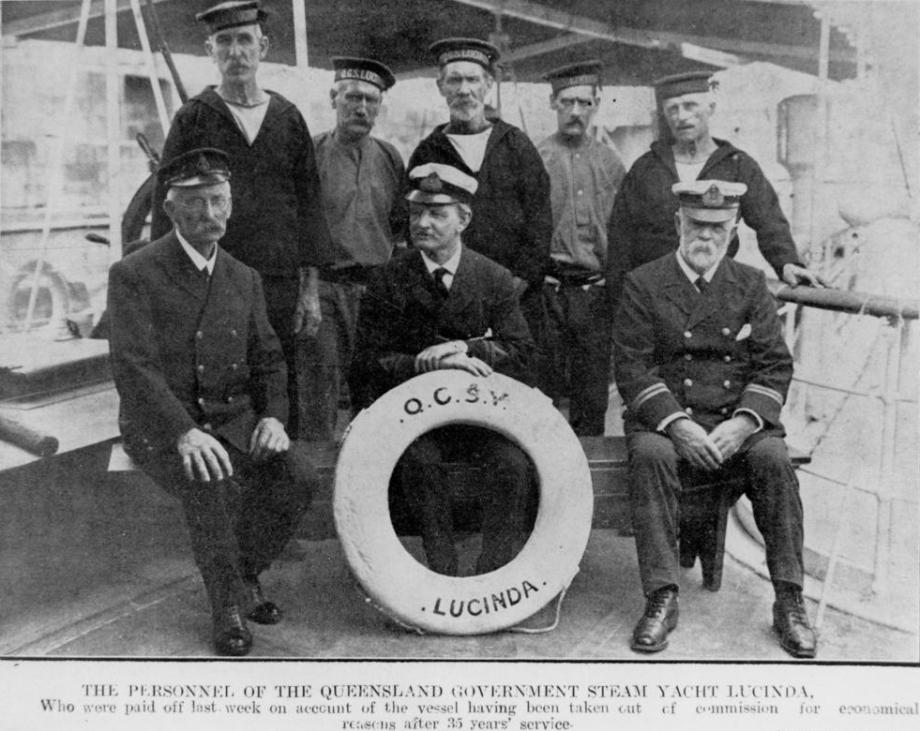
In the group photograph of the Lucinda's personnel on page 24, the names are :—Front row: James Milne (steward), T. L. Craig (captain), G. R. Williams (chief engineer). Back, row: J. Griffin (A.B.), G. Massey .(A.B.), H. M'Gregor (boatswain), J. Arthur, C. Smith.Our Illustrations. (1921, January 22). The Queenslander (Brisbane, Qld. : 1866 - 1939), , p. 36. Retrieved from http://nla.gov.au/nla.news-article22608692
A "LANDMARK" OF FEDERATION.
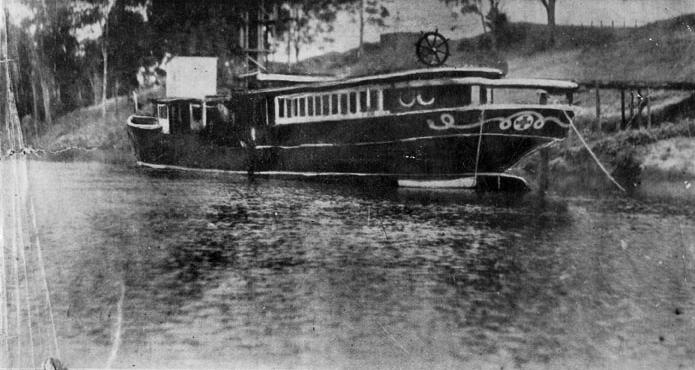
The Queensland Government yacht Lucinda. as she now lies, a "sheer hulk,'' in the Brisbane River, degraded to the position of a sand-boat. It was on this vessel, then the trim ship shown in the illustration at the right, that the Australian Constitution was framed by the Constitution Committee under the leadership of the late Sir Samuel Griffith, the last stage of the drafting being completed on board the Lucinda on the Hawkesbury River from March 27 to 29, 1891.SOME DETAILS OF THE CAPITAL. (1927, May 19). The Queenslander(Brisbane, Qld. : 1866 - 1939), , p. 34. Retrieved from http://nla.gov.au/nla.news-article25296476
Lucinda was sold to the Riverside Coal Transport Company in 1923, who made her coal lighter until the end of her service in May 1932. She was scuttled on the south east side of Bishop Island at the mouth of the Brisbane River. This area has since been covered over and reclaimed as part of the Port of Brisbane expansion.
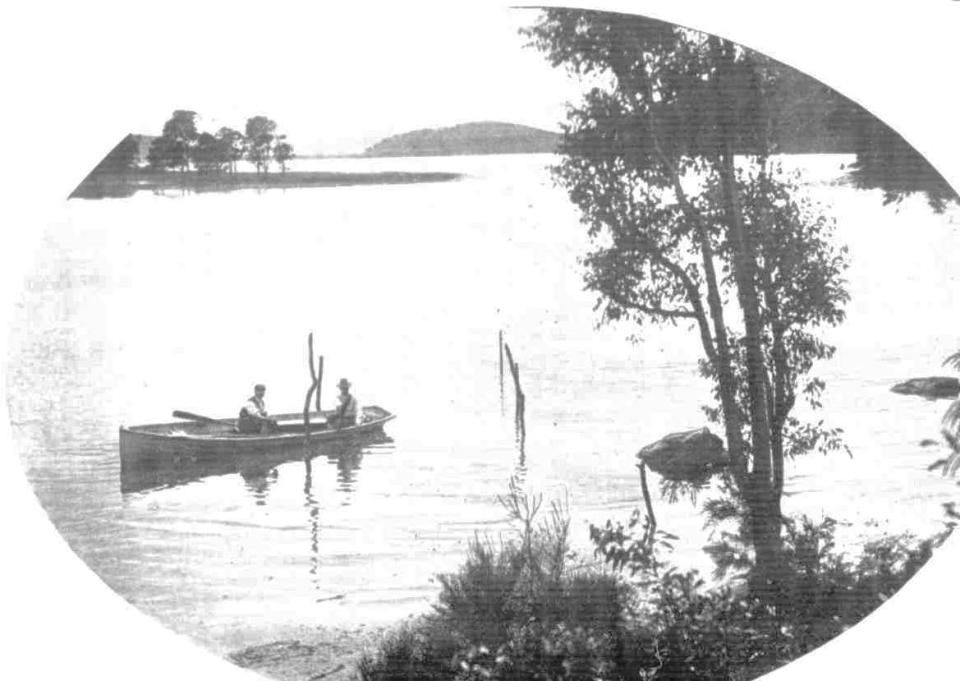
THE BASIN, BARRANJOEY. 1903 The Sydney Mail and New South Wales Advertiser
This shows how wide the entrance to The Basin was and why steamers may have been able to access the 'Inner Basin' or 'Blind Cove' as shown in the 1883 sketch above.
A FAVOURITE HOLIDAY RESORT
THE BASIN, BROKEN BAY
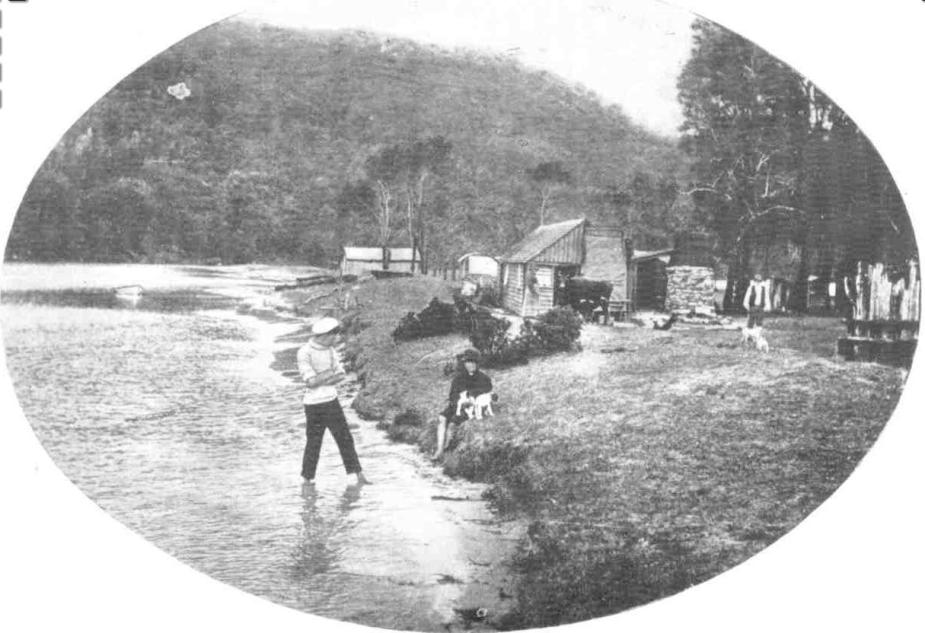
A FISHERMAN'S HOME AT THE BASIN, WHERE MRS. MORRIS HAS RESIDED FOR 37 YEARS.
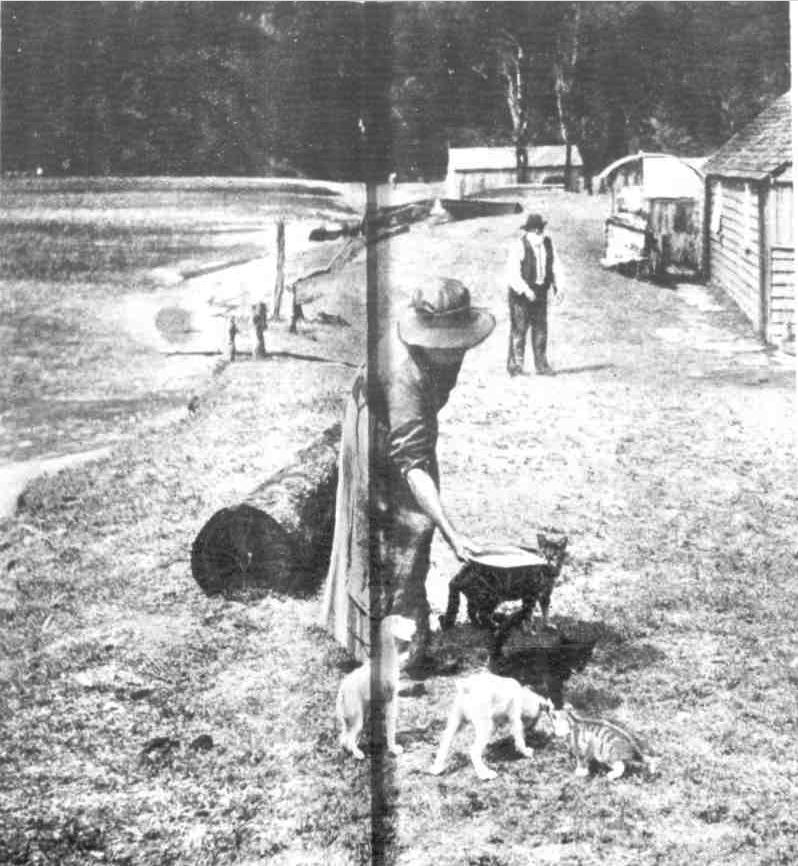
MRS. MORRIS AND HER PETS.
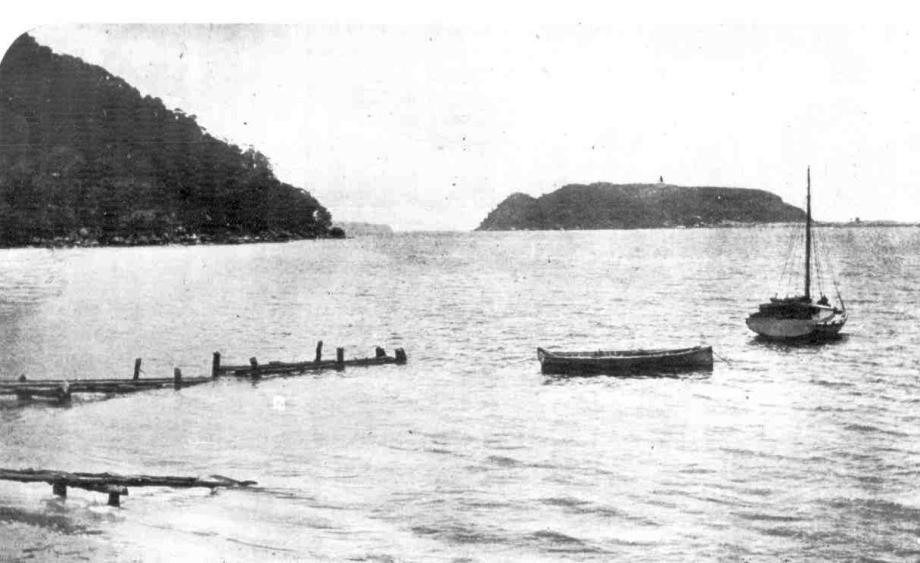
ENTRANCE TO THE HAWKESBURY RIVER. -THE BARRANJOEY LIGHTHOUSE.
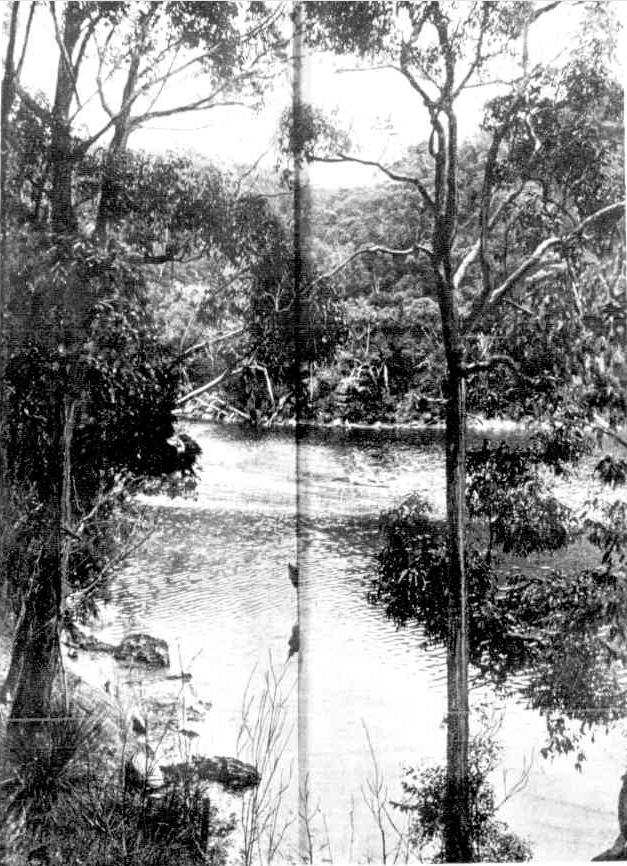
HEAD OF THE BASIN. THE BASIN, BROKEN BAY, NEW SOUTH WALES.
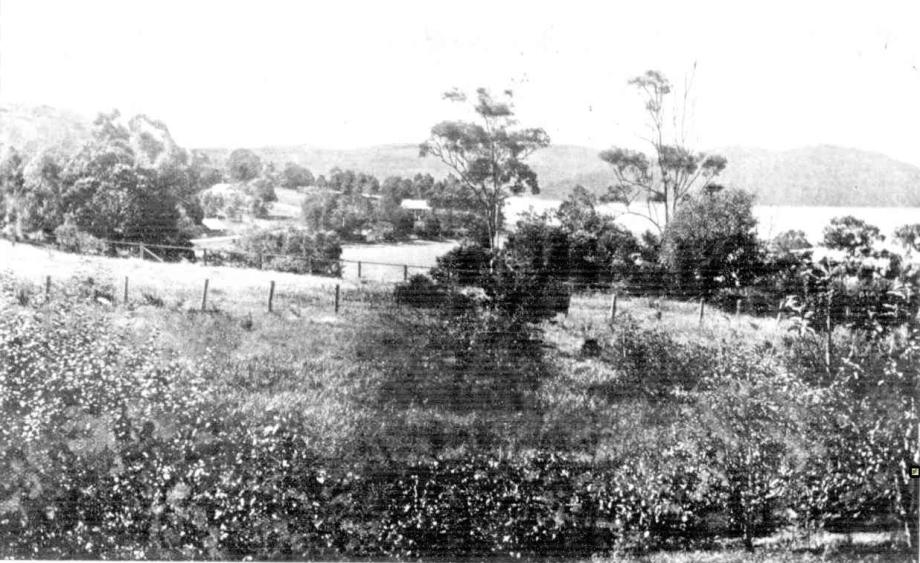
BAY VIEW, PITTWATER. (possibly included here as the photographer was transported to The Basin from the Bayview Wharf)
AN IDEAL CAMPING GROUND, HAWKESBURY RIVER.
A FAVOURITE HOLIDAY RESORT. (1903, December 30). The Sydney Mail and New South Wales Advertiser (NSW : 1871 - 1912), , p. 1706. Retrieved from http://nla.gov.au/nla.news-article164902107
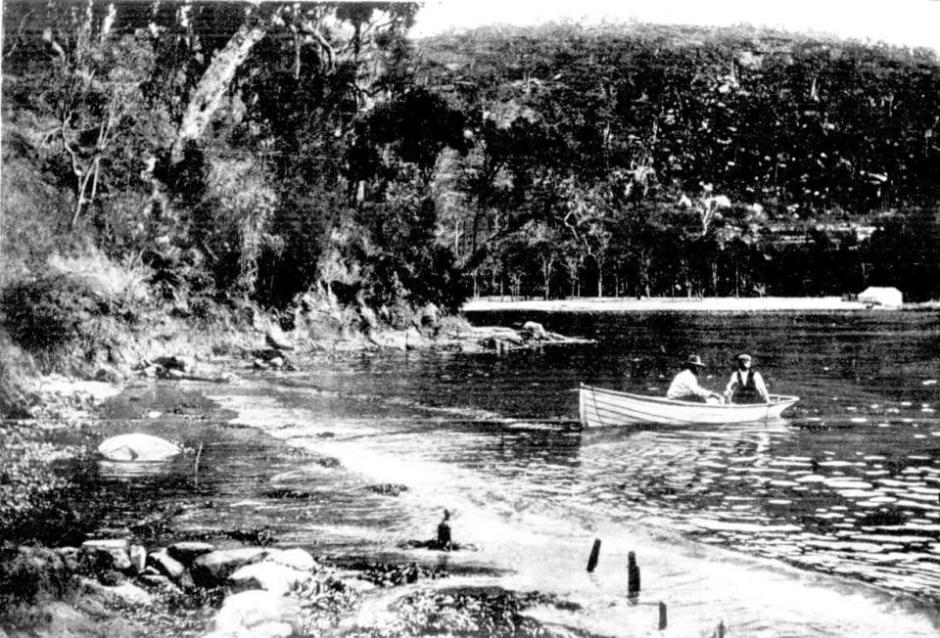
Above: "AN IDEAL CAMPING GROUND, HAWKESBURY RIVER. "1903 The Sydney Mail and New South Wales Advertiser article
Below: "GRILLED FISH FOR BREAKFAST." 1903 The Sydney Mail and New South Wales Advertiser article
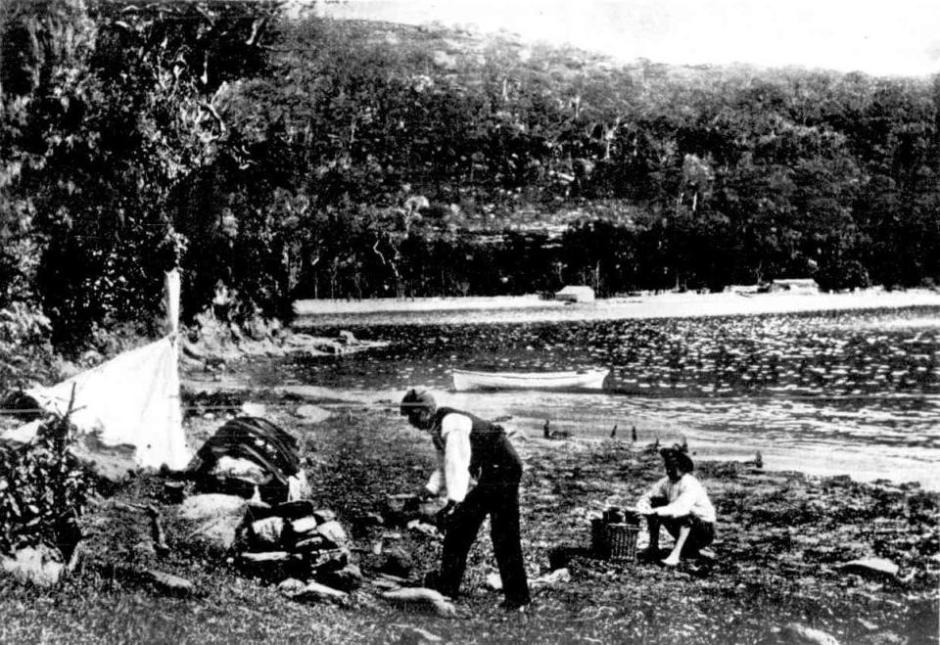
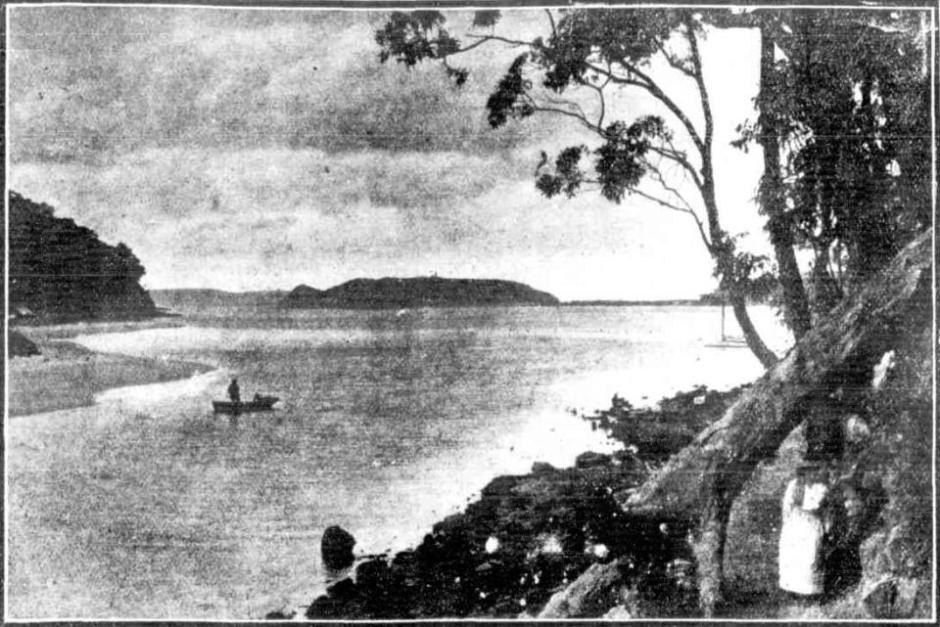
Barrenjoey, the Southern Sentinel Headland of Broken Bay.
The photograph was taken from The Basin, an inlet of Pittwater, where for years the various yachting clubs of Sydney used to rendezvous at Easter. Around The Basin; a path has been cut, leading- zig-zag fashion through a wealth of tropical foliage to the Flagstaff -Lookout at Lovett's Bay, whence a beautiful panoramic view is obtained to .the southwards. . Around the foreshores there are a .number of caves', .while the Kuring-gai Chase trustees have built fireplaces and provided shelter-sheds with tables and watertanks, making the region a delightful one for the holiday-maker..There are several ways of reaching The Basin and the surrounding' country, but the easiest from Sydney is by way of Manly and Newport. A good service of motor boats, several .of them run by returned soldiers, make regular trips.CALL OF THE AIR AND THE SEA. (1920, April 28). Sydney Mail (NSW : 1912 - 1938), , p. 9. Retrieved from http://nla.gov.au/nla.news-article159028149
YACHTSMEN'S FRIEND. THE LATE MRS. MORRIS.
Mrs. Mary Ann Morris, better known to Sydney yachtsmen as "Sally" or "Peggy," died on Monday last at her home at the Basin, Broken Bay, where she had resided for the past 63 years. Her death will be regretted by the yachting fraternity of Sydney, as her hut was a port of call for yachtsmen, when visiting Broken Bay, and they obtained from her supplies of fresh milk and eggs.
Mrs. Morris was the wife of the late Dicey Morris, and, prior to 1867, resided with her husband at Balmoral Beach. About that time her husband sold wood to Admiral Hornby's Flying Squadron during its visit to Sydney, and, with the money thus made, he built the hut at the Basin, Broken Bay, in which Mrs. Morris lived. The couple went to live in this hut at the Basin In 1868, and the husband engaged in fishing there. He did not live long after settling at Broken Bay, and his boat was acquired by a fisherman named Sam Strongman, who also lived at the Basin.
Mrs. Morris kept a few cows and fowls, and was always ready to supply visiting yachts-men with milk and eggs. She also often baked a very welcome damper for them. She adopted three lads at different times, one of whom was with her up to the time of her death. She possessed a good collection of yachting pictures, and recognised every yacht as it dropped anchor In the Basin. Her memory for faces was also very good, and she never forgot the owner of a yacht which had visited the Basin.
She was known to many as "Peggy," while to others she was better known as "Sally." Amongst the oldest members of the yachting fraternity who were well acquainted with Mrs. Morris were the late Mr. H. C. Dangar, the late Mr. James Milson, the late Mr. Grafton Ross, the late Mr. Jack Want, and the late Sir James Fairfax and their various successors, including Mr. F. J. Jackson, who owned the property at the back of the reservation which was subsequently resumed by the Kuringgai Chase Trust.YACHTSMEN'S FRIEND. (1921, June 9 - Thursday).The Sydney Morning Herald (NSW : 1842 - 1954), , p. 9. Retrieved fromhttp://nla.gov.au/nla.news-article15960831
"PEGGY' MEMORIAL
The memorial. In the form of a sundial, erected by Sydney yachtsmen- at "The Basin," Pittwater, to the late Mrs. Morris, well known to all visitors to Broken Bay as "Peggy" will be unveiled at noon tomorrow (Easter Sunday) by Mr. Alfred G. Milson. A large fleet of yachts and cruising craft journeyed to tho Bay for tho Easter holidays, and a good muster of yachtsman is expected at the function. Mr. Paul Ross, commodore R.P.A. Y.C.. is hon, treasurer to the fund, and will be pleased to receive further contributions, as the amount already subscribed Is far from sufficient to cover expenses. "PEGGY' MEMORIAL (1922, April 16). The Sun (Sydney, NSW : 1910 - 1954), , p. 7. Retrieved from http://nla.gov.au/nla.news-article223948591
PEGGY OF THE BASIN.
A sundial mounted on a trachyte pedestal was unveiled as a memorial to the late Mrs. Morris at The Basin, Pittwater, Broken Bay, on Easter Sunday by Mr. Arthur Milson, of the Royal Sydney Yacht Squadron, in the presence of a number of yachtsmen, by whom the funds for its erection were subscribed. Mrs. Morris, who was known to and respected by sailing men as Peggy, lived at The Basin for many years, and was a general favorite. She made it her business and pleasure in life to see to. the comfort of the campers at that favored spot, and her death last year was a great loss to frequenters of the place. PEGGY OF THE BASIN. (1922, April 26).Referee (Sydney, NSW : 1886 - 1939), , p. 5. Retrieved from http://nla.gov.au/nla.news-article127924554
IN HONOUR OF 'SALLY.'
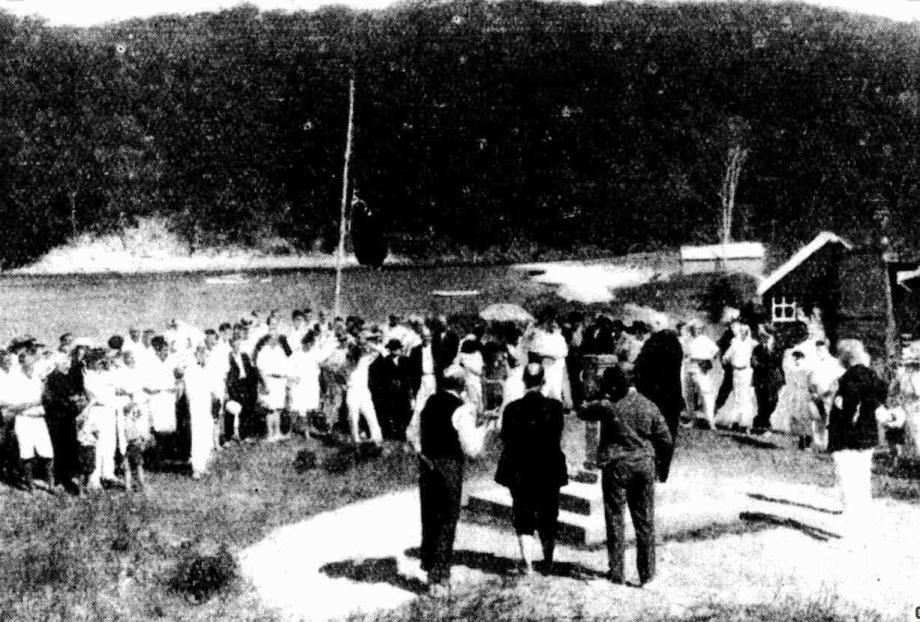
At the Basin, Broken Bay, recently, a sun-dial was unveiled by Mr. A. G. Milson in the presence of a large number of boating men in honour of the late Mrs. Morris ('Sally'), who for: very many years was a friend of the yachtsmen who visited that beautiful spot-. No title (1922, May 10). Sydney Mail (NSW : 1912 - 1938), , p. 32. Retrieved from http://nla.gov.au/nla.news-article169770154
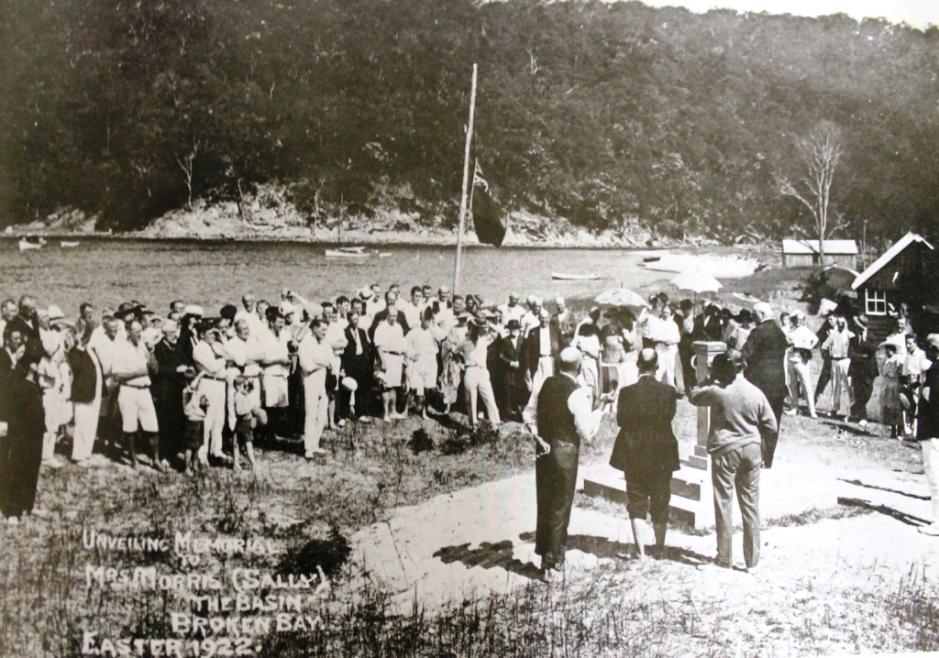
Unveiling Memorial to Mrs. Morris (Sally) - The Basin, Broken Bay - Easter 1922.
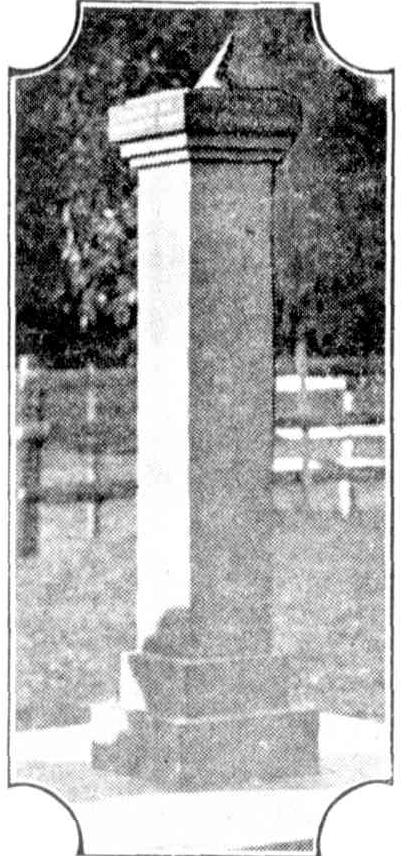
SUNDIAL to the memory of Mrs. Morris ("Sally") at Kuringai Chase.
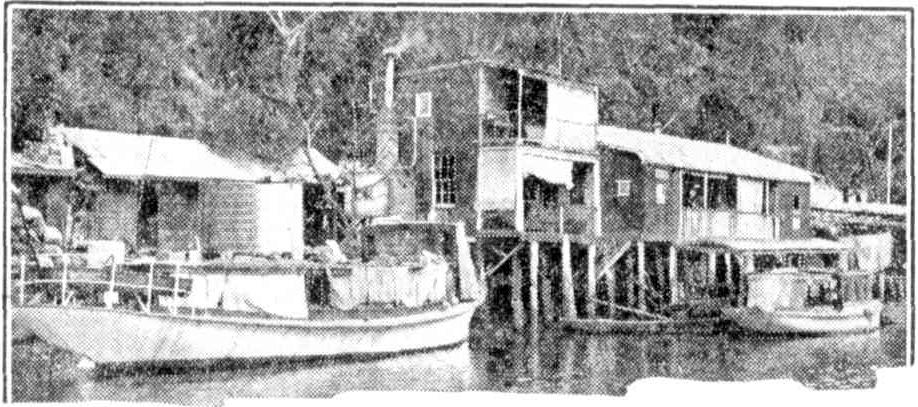
PILE DWELLINGS at Kuringai Chase: — The Windybank boatshed.
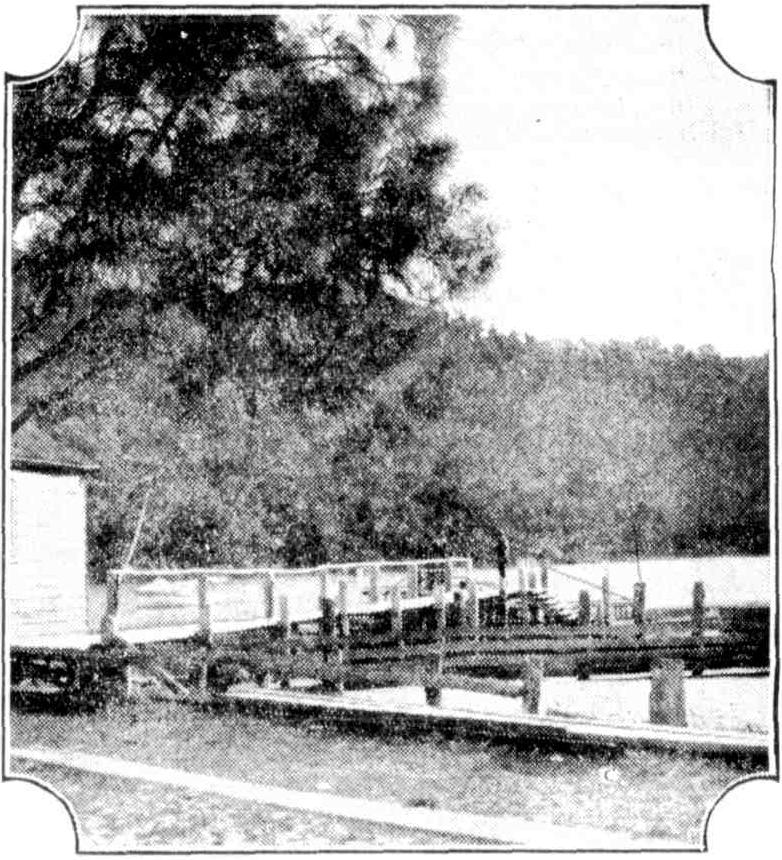
WHARF AT THE BASIN, Kuringai Chase.
Copies of pictures taken by our Photographer are obtainable from the “Sun” Feature Bureau. Through the Eye of a Camera News of the hour in Capical Pictures (1926, September 14). The Sun (Sydney, NSW : 1910 - 1954), , p. 20 (FINAL EXTRA). Retrieved fromhttp://nla.gov.au/nla.news-article222728745
A gentleman of this yachting fraternity, and owner of Topham, or ‘Beechwood Cottage’ (erected in 1882), passed away soon after Mary Ann. Frederick James Jackson purchased the land at the Basin from the previous owner's creditor in 1881. Mary Ann 'Peggy or Sally of The Basin' was paid to clean it and keep and eye on the cottage when the Jackson family and their guests were not using while visiitng:
In the Supreme Court of New South Wales. ECCLESIASTICAL JURISDICTION.
In the goods of William Small, late of Brisbane Water, in the Colony of New South Wales, former, deceased.
NOTICE is hereby given, that after the expiration of fourteen days from the publication hereof in the New South Wales Government Gazette, application will be made to the Supreme Court of New South Wales, in its Ecclesiastical Jurisdiction, that letters of administration of the goods, chattels, credits, and effects of the above named William Small, deceased, may be granted to John Skinner, as Manager of the Oriental Bank Corporation, a creditor of the said deceased.—Dated this first day of April, in the year of our Lord one thousand eight hundred and seventy-eight.
WANT, JOHNSON, & WANT, Proctors for the said John Skinner. 2295 6s. 6d. ECCLESIASTICAL JURISDICTION. (1878, April 2). New South Wales Government Gazette (Sydney, NSW : 1832 - 1900), , p. 1370. Retrieved from http://nla.gov.au/nla.news-article223113095
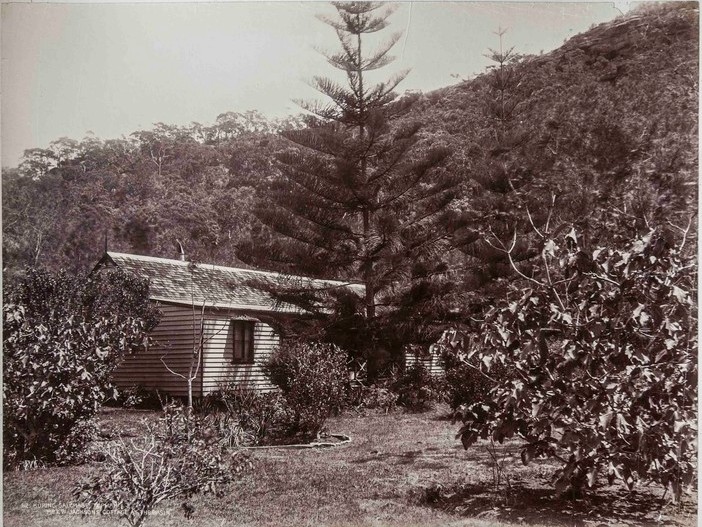
Topham - "Beechwood" also sometimes as 'Beachwood' Mr. F. W. Jackson's cottage at "The Basin"
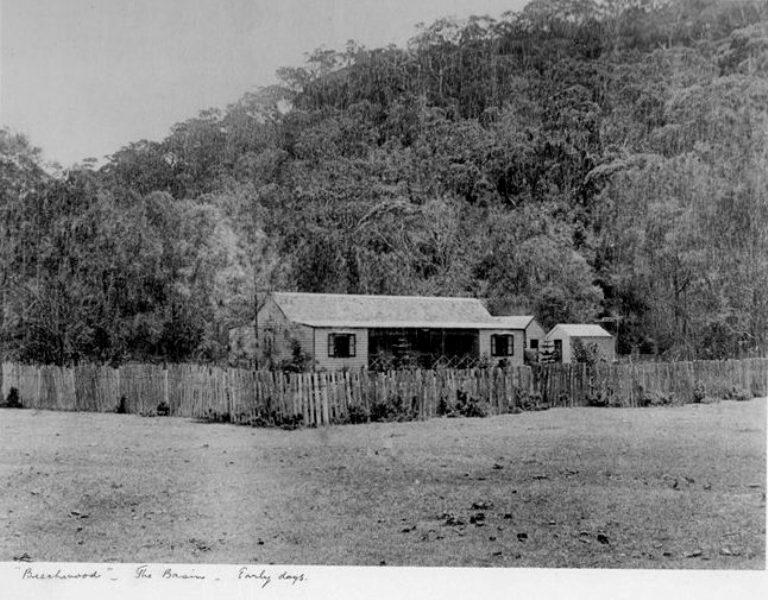
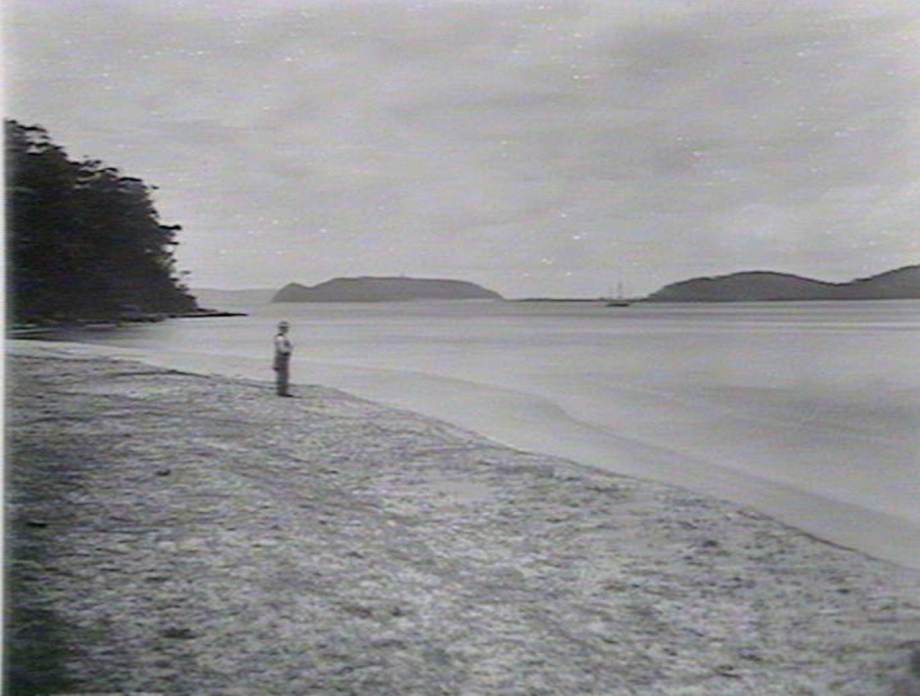
Topham. Coasters Retreat, Pittwater, looking towards. By Barrenjoey Government Printing Office, Image No.: 1 - 08824, courtesy State Library of NSW.
Records indicate there were 70 photographs taken by the Government photographer, Mr O'Dwyer accompanied by Kuring-Gai Chase Board Trustee Eccleston du Faur in 1899, some of the first ever taken in this area, making images of the landscape, waterways and some of the early waterfront businesses which have since vanished.
From Managing Trustee's report 25th October, 1899;
"I have visited Galston road (a similar Departmental work) so as to be able to judge amount of fencing which the Government considers necessary on steep roads of this character, and I am prepared to put the fencing in hand next week. During the past quarter our Co Trustees J. De V Lamb, our Hon. Secretary and the Principal Under Secretary Mr. Critchell Walker and several others visitors have fully inspected the works in progress.
During ten days of the last fortnight (14th-23rd Oct) I have entertained the Government Photographer and his assistant, under authority from the Government Printer, I have had a most successful expedition, returning with 70 full sized plates (15x12) taken all round the Chase, including Pittwater, and illustrating almost every point of interest at present accessible. This involved nearly 150 miles of travelling, mostly in launch or boat, our apparatus being very heavy. After a somewhat trying voyage round "West Head" to Pittwater, on Saturday last when I took the precaution to engage Windybank to take our heavy baggage and to accompany us round to "The Basin", I have been obliged to leave the launch at Newport until the weather clears. This trip has not only involved, the sacrifice of ten consecutive days of my time, but I have had since and have still before me heavy clerical work in recording and cataloguing results and I propose furnishing to the Government Printer a resume of the history of and progress of works in the Chase for insertion in his official albums." - Verbatim from minutes of Board of Trustees meeting 25th October 1899.
"The President reported that Messrs. Du Faur, Wright and himself on Sept. 21 visited the Pittwater Section accompanied by Mr, O’Dwyer, the Government photographer." - From minutes of meeting 25th September, 1900
For more on Eccleston du Faur work top make and retain green areas here, See Pittwater's Parallel Estuary - The Cowan 'Creek' and Pittwater's Lone Rangers - 120 Years of Ku-Ring-Gai Chase and the Men of Flowers Inspired by Eccleston Du Faur
YACHTSMAN AND SPORTSMAN
Mr. Frederick Jackson Passes
Mr. Frederick J. Jackson, who died recently at his residence, Darling Point, linked the past generation of yachtsmen with the present. In the days of the old deep keelers, Mr. Jackson was one of the most enthusiastic and successful sailing men in New South Wales, and more than held his own at the tiller against such redoubtable yachtsmen as Dr. Mackellar, Mr. Alfred Milson, Mr. Edward Knox and the late Mr. Alfred Fairfax, Dr. Milford, Mr. Jack Want and Mr. Prosper Williams. Mr. Jackson was one of the founders of the Royal Prince Alfred Yacht Club, and at the time of his death was the oldest member of the Royal Sydney Yacht Squadron. As far back as the year 1867 he won the yacht race at the Anniversary Regatta with Gitana, an eight-tonner which had been a large half-decker. With this yacht he won numerous races. Later on Mr. Jackson owned the famous yacht Mischief, in which he had years before sailed In English waters. Subsequently he purchased the Ione, and after racing her with success sold her to Mr. Alfred Milson. His last yacht was the well known and stately Violet, which was built for him in 1876 by Langford to the design of D. Hatcher, of Southhampton. Violet, in her early days, was the winner of many races- with her owner at the tiller. In his later years of yachting, however, Mr. Jackson avoided racing, contenting himself with cruising, particularly along the coast, and often sailing to Broken Bay, where he possessed a residence and property. In the '70'8, '80's and '90's Mr. Jackson was one of the inner circle of local yachtsmen, and took a leading part in the control of the sport. Of him it may be said that he was thorough—both as a yachtsman and a gentleman. PERSONALS IN SPORT . (1923, June 6).Referee (Sydney, NSW : 1886 - 1939), p. 1. Retrieved from http://nla.gov.au/nla.news-article128114326
MORE ABOUT A VETERAN YACHTSMAN
The Late Mr. Frederick J. Jackson. His Early Impressions of Sydney
Seventy-two years in business was Mr. Jackson's record, excepting for a painful parenthesis last year, due to a tram accident. He came to Sydney 64 years ago, and his reminiscences connect the London of Charles Dickens with the early days of Sydney. In London as a Junior clerk in an insurance office, he frequently saw on his business errands Queen Victoria and the Prince Consort during the Crimean War, and Empress Eugenie, on her visits to the English Court before the Franco-German War had ended her regal career. In those days, as in the latest, the Interest of his leisure hours was centred in boat-building and sailing. He knew the Thames from quiet Kingston to the troubled tidal-waters of the estuary, and In this neighborhood he lost his first boat and gained some unexpected experience from a bibulous sailor engaged to Instruct him.
FIRST PEEP AT SYDNEY.
Of his first morning in New South Wales Mr. Jackson had a keen recollection: 'I was 'Staying at a hotel near St. Phillip's Church,' he related. 'After a restless night I rose early, anxious to see what Sydney was like, and what prospects it offered externally for business. I walked down Jamieson-street Into George-street, and turned towards the Quay. In those days it was Chinese quarters. The houses were for the most part mere shanties, dismal looking and squalid. They say that 'first impressions go a long way!' My first Impressions had a most depressing effect on my spirits.' : I could see no prospects of establishing a branch of the insurance company I represented, and had a strong inclination to find a good ship going home, and embark at once.
A YACHTING VISION.
However, I continued my walk, crossed the Domain and sat down near Mrs. Macquarie's Chair to contemplate the waters of the Harbor. What a vision for a yachtsman! A seven-ton yacht was riding at her moorings, and a great desire seized me to sail a boat like that across the dancing waters and explore the distant bay's. As such possibilities occurred to me I forgot my wish to return to England, at least for the present. On my return to the hotel I learned that the owner of that fascinating little craft was about to leave Australia, and was offering it for sale. Eventually I found myself the happy owner, and I fully believe that yachting has saved my life.' There Is nothing better to rest and refresh a busy man. The change of thought, the glorious salt air, and the companionship of men united in a love of Nature and adventure makes yachting the ideal sport. During my earlier years in Australia I had a serious illness, some lung trouble apparently, and the doctors, Melbourne doctors, by the way, forecasted my decease in a fortnight. That was over sixty years ago!' Mr. Jackson was the only surviving founder of the Royal Sydney Yacht Squadron, and the 'father' of the Royal Prince Alfred Yacht Club.' PERSONALS IN SPORT. (1923, June 13). Referee (Sydney, NSW : 1886 - 1939), p. 1. Retrieved from http://nla.gov.au/nla.news-article128116707
THE LATE F. J. JACKSON
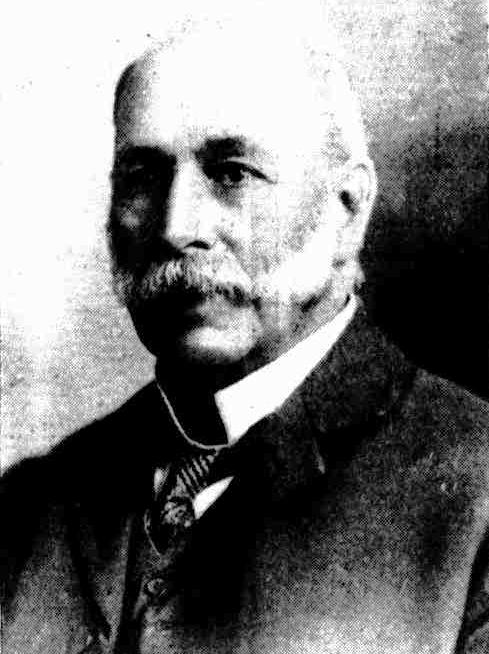 THE recent death of Mr. F. J. Jackson represents a loss to the business world of Sydney of one of the most well-known and highly-esteemed men in insurance circles, and it has removed from the social sphere of his private life a famous yachtsman and picturesque figure in the clubs to which he belonged. Mr. Jackson came to Australia with a wide knowledge of insurance to establish the European Assurance company, and the general management of that company's affairs was in his hands while it continued operations in Australasia and New Zealand. He then joined the Victoria Insurance Companies, and started their career in New South Wales, opening the branch office in Sydney as resident secretary of the Victoria Insurance Company, Victoria Life and General Company, and the Victoria General and Guarantee Company. It was in this position prior to his retirement from the active management of the first mentioned company in 1901 that he became a notable personality amongst insurance men in Sydney, being a prime mover in every project lending to advance the interests of insurance companies in general and his own in particular. He was one of the original members, on its formation, of the Sydney Underwriters' Association, a prominent member of the committee, and chairman on a number of occasions, and he acted as the first chairman of the present existing association, known as the Sydney Marine Underwriters' and Salvage Association, Limited, which was formed in 1898 from the original Underwriters Association. He was for some time also a member of the committee of the Fire Underwriters' Association of New South Wales, a member of the Sydney Chamber of Commerce, and at one period one of the two representatives of the insurance companies on the New South Wales Fire Brigades' Board. Quite a number of successful business concerns owed much to his advice and foresight in the early direction of their policy. He retired from the active management of the Victoria Insurance Company in 1901, but carried on the secretaryship of the Victoria Life and General Company and the Victoria General and Guarantee Company until the date of his death.
THE recent death of Mr. F. J. Jackson represents a loss to the business world of Sydney of one of the most well-known and highly-esteemed men in insurance circles, and it has removed from the social sphere of his private life a famous yachtsman and picturesque figure in the clubs to which he belonged. Mr. Jackson came to Australia with a wide knowledge of insurance to establish the European Assurance company, and the general management of that company's affairs was in his hands while it continued operations in Australasia and New Zealand. He then joined the Victoria Insurance Companies, and started their career in New South Wales, opening the branch office in Sydney as resident secretary of the Victoria Insurance Company, Victoria Life and General Company, and the Victoria General and Guarantee Company. It was in this position prior to his retirement from the active management of the first mentioned company in 1901 that he became a notable personality amongst insurance men in Sydney, being a prime mover in every project lending to advance the interests of insurance companies in general and his own in particular. He was one of the original members, on its formation, of the Sydney Underwriters' Association, a prominent member of the committee, and chairman on a number of occasions, and he acted as the first chairman of the present existing association, known as the Sydney Marine Underwriters' and Salvage Association, Limited, which was formed in 1898 from the original Underwriters Association. He was for some time also a member of the committee of the Fire Underwriters' Association of New South Wales, a member of the Sydney Chamber of Commerce, and at one period one of the two representatives of the insurance companies on the New South Wales Fire Brigades' Board. Quite a number of successful business concerns owed much to his advice and foresight in the early direction of their policy. He retired from the active management of the Victoria Insurance Company in 1901, but carried on the secretaryship of the Victoria Life and General Company and the Victoria General and Guarantee Company until the date of his death.
A keen observer, who had seen, many changes with the growth and progress of the State, he was greatly interested in historical records, and was an enthusiastic member of the Royal Australian Historical Society. Mr. Jackson was a sailorman at heart. He held a record of many years' service in the defence forces of New South Wales — naturally in the naval branch of the service, and he worked strenuously for the advancement and efficiency of the New South Wales Naval Brigade, of which he was the senior lieutenant; when it merged into the Commonwealth Naval Force, and in the latter he held the rank of lieutenant-commander on the retired list at the time of his death.
F. J. JACKSON'S name will long be remembered in the annals of. yachting, and amongst those who enjoyed this form of recreation during the era of sails and with the more modern use of motors. Having been a keen yachtsman in England in the waters on either side of the Thames, he was not long without a yacht to cruise in after his arrival in Sydney, and he owned a number of yachts well known in Sydney Harbour at different times. Perhaps the most famous of these in her day was the 10-ton cutter Violet, in which he won many prizes and cruised for many years along the New South Wales coast to Broken Bay, until, moving with the times, he adopted the motor launch as the means of following the call of the sea. His motor launch Valeria carried the flag of the Royal Prince Alfred Yacht Club until the close of the last yachting season in Sydney. He was one of the original 19 members and founders of the Royal Sydney Yacht Club and one of the oldest members of the Royal Prince Alfred Yacht Club, life membership of the latter institution having been conferred on him in recognition of his invaluable services I o yachting. He left a widow and one daughter and four sons.THE LATE F. J. JACKSON (1923, June 27). Sydney Mail (NSW : 1912 - 1938), , p. 46. Retrieved from http://nla.gov.au/nla.news-article159025457
OLD-TIME CORINTHIANS.
FREDERICK J. JACKSON.
(By 'CORINTHIAN.')
We of the present day are apt to forget what we owe to the pioneers of yachting in these waters. The difficulties of all descriptions which arose only to be overcome, and the benefit to sport thereby, must have been enormous. Such enterprise In the push by the pioneers has Placed the pastime of sailing generally on a sound footing. For Instance, in last Saturday's sailing events there were 93 entries, and this
fleet probably carried crews numbering close on 600. How many of those participants ever give a thought to those who made it possible for them to compete under well-drawn-up rules and conditions, for the various prizes that were competed for? It Is well at times to take a look back and honor those who 'blazed the track.' It is safe to say that we have among us the oldest Corinthian south of the line, in the person of Mr. F. J. Jackson, who, since 1881, has held the position of secretary of the Victoria Insurance Company, and is esteemed among yachting men and commercial men alike. Before reaching these shores Mr. Jackson, who is a Londoner by birth, but by residence and adoption can now be called an Australian, got his baptism at the hands of Father Neptune. This occurred when ho was thirteen years of age. At that time he and his brother purchased a 9-ton yawl. Neither of the budding Corinthians thoroughly understood the management of their property, and they were compelled to employ a professional to give Instruction. This Individual took them out Ina howling gale, and, after being out ail night, landed them on the Essex shore at dusk on the following evening. Shortly afterwards the gale Increased, and their mentor, who had been left in charge, forsaking the shrine of Neptune for that of Bacchus, allowed her to drag her anchors, and she, in consequence, become a total wreck. The unfortunate occurrence did not kill Mr. Jackson's love of the sea though his brother declined to join In another such venture. Within six months he purchased the Hero, of nine tons, and during his ownership of this craft familiarised himself with ll the ways of the sea. He next bought Ellen, then Brilliant, Bantam, Kate, and lastly the 11-tonner Traveller. The chosen cruising ground was the Thames estuary and Its upper reaches. Mr. Jackson was cruising off the north of Foreland when the Australian steamer Royal Charter was wrecked close by in a heavy gale. He himself only managed to gain safety after a hard battle with the elements.
On arrival at Sydney, at the age of twenty three, he was disappointed to fin that there was no yacht club In existence, the Sydney Club having become extinct. Within six months of his arrival he purchased Gitana, a 7-tonner, and won several prizes with her in subsequent regattas. Gitana was run Into by a steamer, and then was afterwards lengthened, growing in size to 10 tons. After dispoing of her he bought Mischief, which was transported from the Old Land by the late Mr. James Milson in 1865. Mr. Jackson was not unacquainted with Mischief having enjoyed a sail in her before his departure from England. He also came across a 9-tonner called Julia which he had been in process of building at Samuel Pepy’s Yards, Blackwall, London. Mischief was raced with varying success.
It was at this time that the Royal Sydney Yacht Squadron arose from the ashes of the Sydney Club. Mr. Jackson was one of the original members of that Institution, and the only one now alive that has owned a credit throughout his connection with it. He was a member of the first committee, and continued in that capacity for a number of years, finally retiring. After parting with Mischief, Mr. Jackson sailed Ione, previously the property of Mr. Grafton Ross, and won a number of races with her. In 1877 Mr. Jackson sent to Hatcher, of Southampton, who was famed as a designer at that time, for the plans of a 10-tonner. As a result the famous Violet was built locally by the late W. Langford. Her success was phenomenal, being finally so heavily handicapped that success was impossible. She Is credited with being the last yachts designed by Hatcher, and when Mr. Jackson sold her he closed his racing career, having won in various boats owned by him in England and Australia about 15 prizes. Since those days be has owned various craft, both motor and steam, Valeria being of the latter. Mr. Jackson was for twenty-three years associated with the local Naval Brigade, during the time the old Wolverine, afterwards broken up at Auckland. N.Z., was at the corps disposal for sea training. He holds a coast masters certificate by examination. The Royal Prince Alfred Yacht Club conferred Life membership upon Mr. Jackson In recognition of his Invaluable services to yachting. Mr. Jackson has lived happily lo see the waters of Port Jackson studded with craft of all descriptions— In contrast to the small number of white wings that ploughed IU depths when the world was rather younger. OLD-TIE CORINTHIANS. (1913, November 8). Saturday Referee and the Arrow (Sydney, NSW : 1912 - 1916), p. 3 Supplement: ISSUED AS A SUPPLEMENT WITH THE SATURDAY REFEREE. Retrieved from http://nla.gov.au/nla.news-article117417916
Mr. Jackson was among those who objected to The Basin being used for Oyster leases:
Objections to Extensive Oyster Leases.-Recently the Fisheries Board decided to lease 10,000 yards of foreshore In Pittwater to an enterprising man for oyster-fattening beds. The area was not continuous, but scattered round Pittwater, Bayview, Newport, Careel Bay, The Basin, and Saltpan Point. Several objections were, however, resolved to the leasing, residents having water frontages urging that there would be depreciation of their property, interference with their water approach, and deprivation of net-fishermen by taking away their hauling grounds. They also pointed out that unsightly stakes and stones would be laid on the leases in connection with oyster culture, and that the sewage from houses round this arm of Broken Bay would make the oysters dangerous food. Mr. F. Farnell (chairman of the board) and Mr. J. A. Brodie (chief inspector) paid a visit to the place a few days ago to Investigate the validity of the objections, and reported that none of the objections was tenable. Provision had been made for boat access to properties abutting on the lease, the hauling grounds were not to be leased, the Navigation Department had no objection to the erection of ballast walls to protect the oyster banks at Careel Bay and Saltpan Point so long as they did not extend further out than low water mark, and there was no danger of the oysters becoming affected by sewage. With this report before It the board decided to grant the majority of the leases, but set apart Towler's and Lovett's Bays and other parts used by the public for public oyster reserves.FRANCE REFUSES SOCIALISM. (1906, August 4). The Sydney Morning Herald (NSW : 1842 - 1954), p. 10. Retrieved from http://nla.gov.au/nla.news-article14791145
Mr. Hogue: No one had any right to order the public off the proposed leases.
Mr. T. A. Dibbs pointed out that the Ku-ring-gai Chase trustees and the Fisheries Board had overlapping control of the foreshores of the park. At Coal and Candle Creek a few years ago all the oysters were cleaned out by someone's authority.
Mr. Trevor Jones said that section 4S of the Fisheries Act, relating to leases, left it open for existing lessees to give the public much trouble if they accidentally trespassed on the leases or disturbed the oysters.
Dr. Arthur: Can the people who ordered the public off the foreshores be punished fordoing so?
Mr. J. T. Swanson said that the Fisheries Board had an inspection of the leases recently, but did not let the objectors know; they were coming.
Mr. Hogue, In reply, said he would not express any opinion as to whether those who ordered people off the leases could be punished, but they had no legal right to do so. The Fisheries Board was charged with the administration of the Act, and he had been prepared to grant the leases on its recommendation, but when Mr. James Clarke's applications for leases came before him, and were followed by the objections, he suspended their issue till he heard more from the people most concerned. He had to encourage the oyster industry on the one hand and see that settlement of the people was not retarded on the other. People could not be given a right to wander all over the leases when they were granted. If they were, the oysters would soon disappear. Mr. Clarke was an enterprising man, who had made a life-long study of oyster culture, and it was his duty to give him encouragement. At the same time the granting of the leases did not give the lessee the right to warn people off. He would meet the objectors by not granting the leases at the Basin and on Ku-ring-gai .Chase, and would consider others, but the majority of the leases did not inter-fere with the public enjoyment, and would be granted. OYSTER LEASES AND PUBLIC RIGHTS. (1906, August 23).The Sydney Morning Herald (NSW : 1842 - 1954), p. 3. Retrieved from http://nla.gov.au/nla.news-article14797671
More in Oystering in the Pittwater Estuary - Oyster Kings and Pearl Kings and When Not to Harvest Oysters
The area encompassing ‘The Basin’ on Pittwater was purchased in 1915 by the Kuring-gai Chase Trust from Mr. Jackson.
Sydney, 17th May, 1929. IT is hereby notified that in accordance with the provisions of the 26th section of the Crown Lands Consolidation Act, 1913, Thomas Walter Spencer, Esquire, is hereby appointed in the place of Mr. R. J. Greig, resigned, as a Trustee of Ku-ring-gai Chase, Hawkesbury River, area about 35,300 acres, dedicated 14th December, 1894, for Public Recreation, and the following additions thereto, namely: 3 acres 1 rood 20 perches at Towler's Bay, Pittwater, dedicated 12th July, 1931; 7 acres 1 rood and 15 acres at Coaster's Retreat, Pittwater, dedicated 2nd August, 1911; and 42 acres 2 roods 7 perches at The Basin, Pittwater, dedicated 31st August, 1917. [Misc. 1929-3,314] R. T. BALL, Minister for Lands.Government Gazette Appointments and Employment (1929, May 17). Government Gazette of the State of New South Wales (Sydney, NSW : 1901 - 2001), , p. 2089. Retrieved from http://nla.gov.au/nla.news-article223021175
An example of the area being used, including the other spelling of "Beechwood":
BOYS' CAMP AT PITTWATER
In the pretty spot at Coasters' Retreat, Pittwater, opposite Palm Beach, a camp is to be conducted, on splendid lines, for boys, from December 18; and .parents in the Cootamundra district who would like to see their lads a good time, should call at our office and see tho full details, or write to the director, Mr. Hugh wuui. jun., 511 New South Head Road, Sydney. The entire activities of 'Camp Enterprise', will be supervised by Mr. Ward, who Is an experienced camper and yachtsman. He has cruised on the Barrier Reef and New South Wales coastal waters, and has spent some time at a famous boys' summer camp in tho Green Mountains, Vermont, U.S.A. Over ten years' experience in catering to the wants of the public in the amusement business, and a knowledge of what boys enjoy most, make Mr. Ward a most competent man to direct operations. The swimming baths are great, being shark-proof, with a beautiful white sandy bottom, wonderfully suitable for teaching and developing non-swimmers, and at the same time interesting to the most competent. The boys will have the use of the entire camp equipment, under the control of the director and counsellors, on the inner and outer basins, and in addition expeditions In the motor boats 'Murela' and ''Grace VII.' will be made outside for schnapper fishing when conditions permit; and exploratory trips to Barranjoey Light House, Lion Island, Refuge Bay, Patonga. Cowan Creek, and other places will be made frequently. Pittwater and the Hawkesbury Estuary abound in nooks and corners that simply demand investigation, and the boys will be afforded every opportunity to explore and fossick about.. Mackerel,. yellowtail, and bream are plentiful near the camp, and give great run on light tackle. The bush about the camp is in its natural state, and the hills are rough and suitable for climbing. Those who like biking will have plenty at scope, while the sailing boat, rowing boats, motor boats, and baths will enthral those who prefer the water. One of the counsellors will be an expert sailing man; and all the boys, from the youngest to the oldest, will have .a chance to learn something of the art of handling a sailing boat ' if they, have the Inclination to do so.'
There is a properly laid but cricket pitch adjoining the cottage. All those boys who are backward in the art of swimming will be taught. Every effort will be made by the instructor, not merely to teach the boys to paddle .about, but to do the modern strokes, so that, if they happen to show any real aptitude and ability for the sport, they will have a sound basis for their efforts.
The main building of the camp is a large weatherboard cottage, the. living, rooms, and verandahs of which will be used as the dining quarters. and for lectures and games in the evenings. This substantial house will ensure top production of good food under all weather conditions, and it will be the rallying point and centre of the camp's activities. The boys will sleep in large Waterproof tents on beds, mattresses and .pillows supplied and maintained by the camp.
“Beachwood” is well finished. Parents are welcome at all times, and arrangements have been made for their accommodation should they desire it, so the can see the conditions under which the camp is conducted. One of the counsellors is a competent 'first-aid, man, and a doctor can be telephoned and brought to the camp in less than half an hour should the need arise. There will be no rigid 'army' type of discipline, and no corporal' punishment of any kind; but boys who do not behave in a satisfactory manner will be dealt with by the director. As the arrangements at the camp are complete; to the last detail the director reassures parents not to supply the boys with any pocket money.
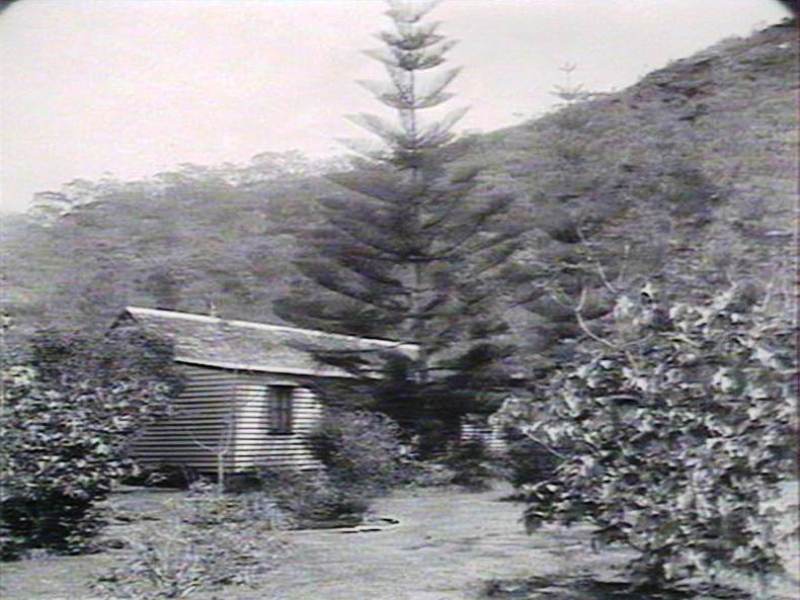
Topham. F.W. Jackson's Cottage at The Basin, Government Printing Office 1 - 08825, courtesy State Library of NSW.
The fee paid for attendance at camp covers every item. Finance: Period A, commencing December 18th, till school reopening (about 8 .weeks), 24 guineas; period B, December 28th till school reopening (about 7 weeks), 21 guineas; period, C, January 2 till school reopening (about 6 weeks), 19 guineas, period D, a fortnightly rate; £7/10/. Terms, 10 per cent, on application, the balance on departure for camp. BOYS' CAMP AT PITTWATER (1931, October 26). Cootamundra Herald (NSW : 1877 - 1954), p. 4. Retrieved fromhttp://nla.gov.au/nla.news-article139102599
In 1967, following 73 years of management by the Ku-ring-gai Chase Trust, the Chase was declared a national park under the NPWS Act 1967. Spectacle Island was dedicated as a reserve for public recreation in 1919 and as a nature reserve in 1972. In 1891 Long Island was reserved for public recreation and in 1972 became a nature reserve except for railway uses. Lion Island, dedicated as a fauna reserve in 1956, was also dedicated as a nature reserve under the NPWS Act 1967.
Another change for those accessing the area via vessel:
PROCLAMATION. NAVIGATION ACT, 1901, N.S.W.
I Sir Philip Woolcott Game, Governor of the State of New South Wales and its Dependencies, in the Commonwealth of Australia, with the advice of the Executive Council, and in pursuance of the powers and authorities vested in me by the Navigation Act, 1901, do, by this Proclamation, declare that the waters within The Basin, Coasters Retreat, Pittwater, discharging into Broken Bay shall, on and after the first day of February, 1931, be a harbour wherein all vessels, shall proceed at a speed not exceeding four (4) nautical miles per hour and such reduced speed shall be observed after passing to the westward of the Stone Wharf on the south side of The Basin channel.
Signed and sealed at Sydney, this third day of February, 1931. PHILIP GAME, Governor. By His Excellency's Command, JOHN T. LANG, Colonial Treasurer. PROCLAMATION. (1931, February 13). Government Gazette of the State of New South Wales (Sydney, NSW : 1901 - 2001), , p. 677. Retrieved from http://nla.gov.au/nla.news-article220236343
Easter Cruises to Pittwater - from 1893
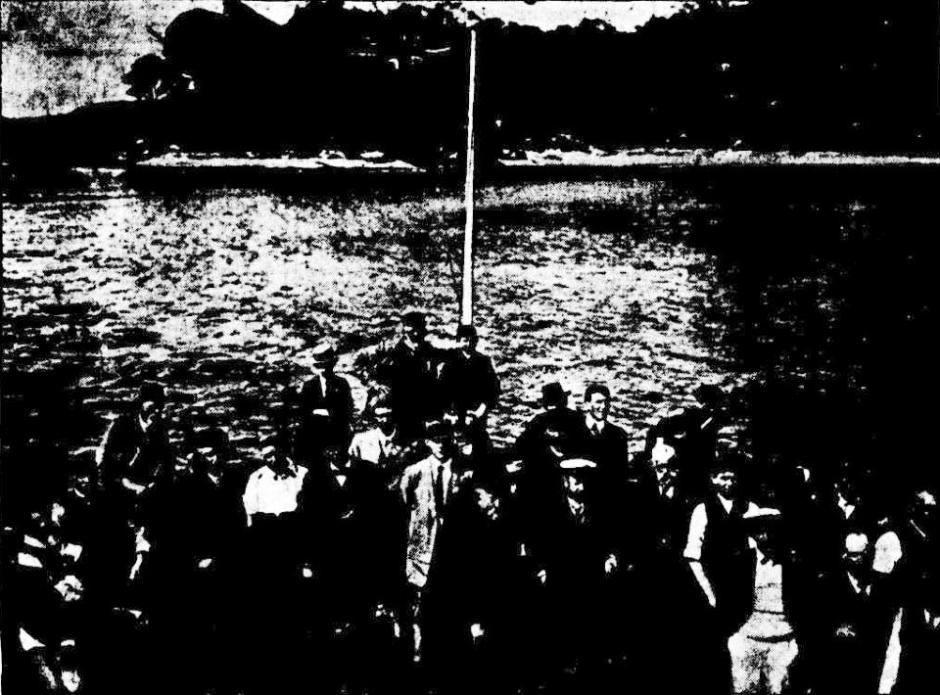
PROMINENT P.A.Y.C. OFFICIALS ABOARD THE STEAMER BOBBIE BURNS. FOLLOWING THE 'BASIN CUP' RACE LAST SATURDAY. THE STEAMER IS SHOWN AT BROKEN BAY. No title (1911, February 15). Referee (Sydney, NSW : 1886 - 1939), , p. 15. Retrieved from http://nla.gov.au/nla.news-article129932426
JUST AFTER THE START OF THE R.P.A.Y.C. RACE ON SATURDAY FOR THE BASIN CUP.
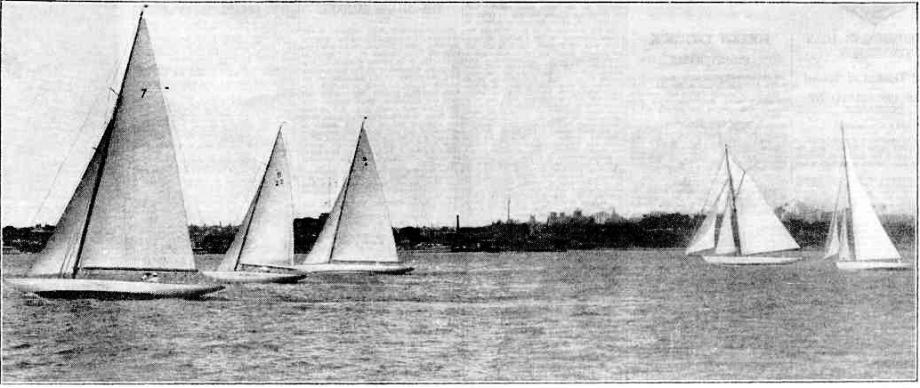
Morna (R. C. Packer), the winner, is second from the right. Utiekah II. (H. Nossiter), which came second, is on the extreme right. The third boat, Norn (A. F. Albert), is on the extreme left. The Victorian visitors, Toogooloowoo II. (B22) and Vanessa (R4), were fifth and fourth respectively. JUST AFTER THE START OF THE R.P.A.Y.C. RACE ON SATURDAY FOR THE BASIN CUP. (1932, January 18). The Sydney Morning Herald (NSW : 1842 - 1954), , p. 12. Retrieved from http://nla.gov.au/nla.news-article1683448
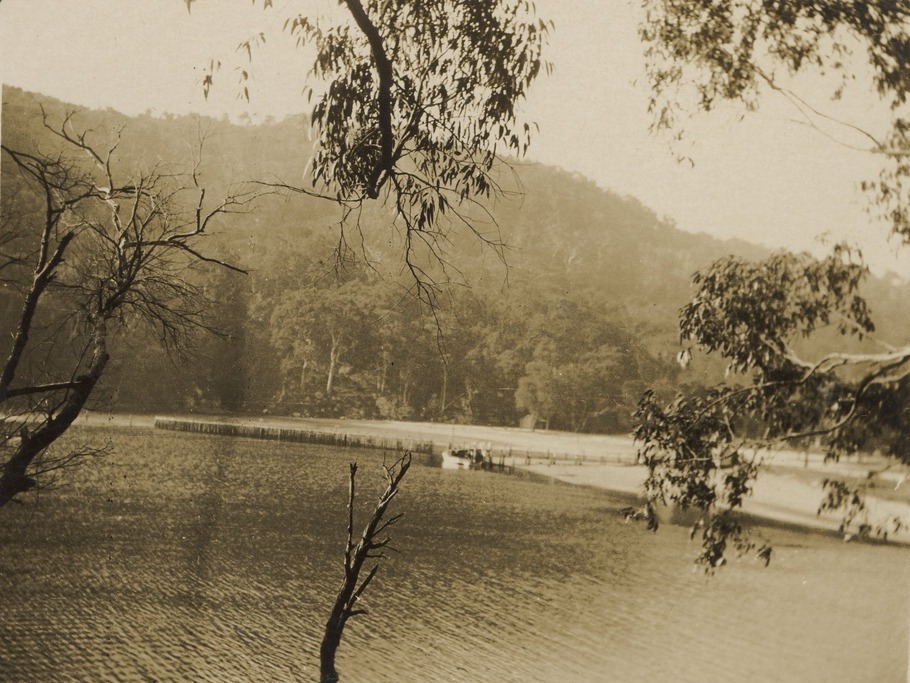
"The Basin Swimming pool Pittwater" - "Looking across water towards bushland rising in background, fence visible across surface of water." Title continues: "The fence is to keep the sharks out." [ca. 1926-ca. 1928].by Gladys E. Moss, 1900-1950, photographer. "The Basin; Pittwater" - Title inscribed on album page beneath image.- Courtesy State Library of Victori, Image No. :701711210
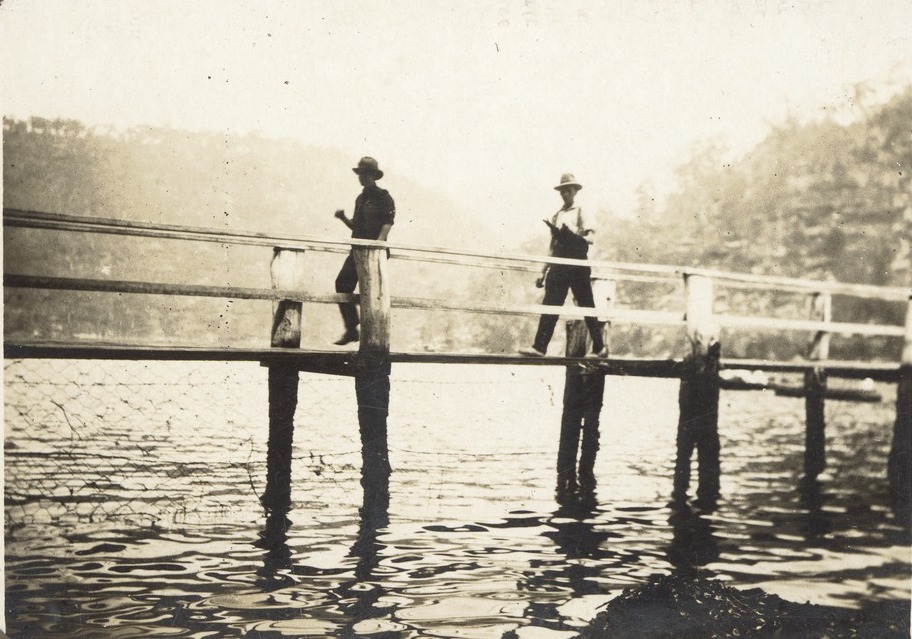
"Looking along water towards two men walking across wooden bridge". Inscribed on album page next to image: "The netting under the footbridge keeps the sharks from the bathing-pool on this side. The rock in the foreground is jagged with oysters." [ca. 1926-ca. 1928].by Gladys E. Moss, 1900-1950, photographer. "The Basin; Pittwater" - Title inscribed on album page beneath image. Courtesy State Library of Victoria - also described as 'an inlet of Cowan creek' for Image No.: 701711211
Gladys E. Moss, 1900-1950, was a Sydney Mail photographer during the 1920's - we have shared some of her images in another page In Surf Life Saving Carnival Season: A Glance at Surf Carnivals in February 1909, 1919, 1925, a Fancy Dress Rise of Venus and Saving Lives with Surfboards
She attended Sydney University;
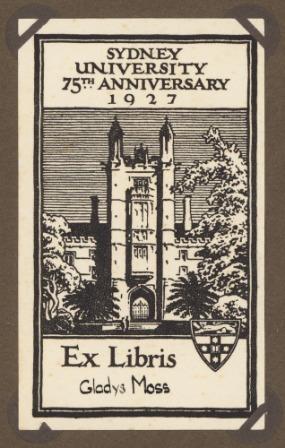
and was obviously out with girlfriends when the pictures below were taken:
Barrenjoey Head and lighthouse, [Sydney, NSW] [picture]. by Gladys E. Moss, Gladys E.,. 1900-1950,. photographer. Barrenjoey Head and lighthouse, [Sydney, N.S.W.]. [picture 0_1711215]. [ca. 1926-ca. 1928]. and On a lookout in Kuringai Chase, N.S.W.] [picture]. (2 frames)
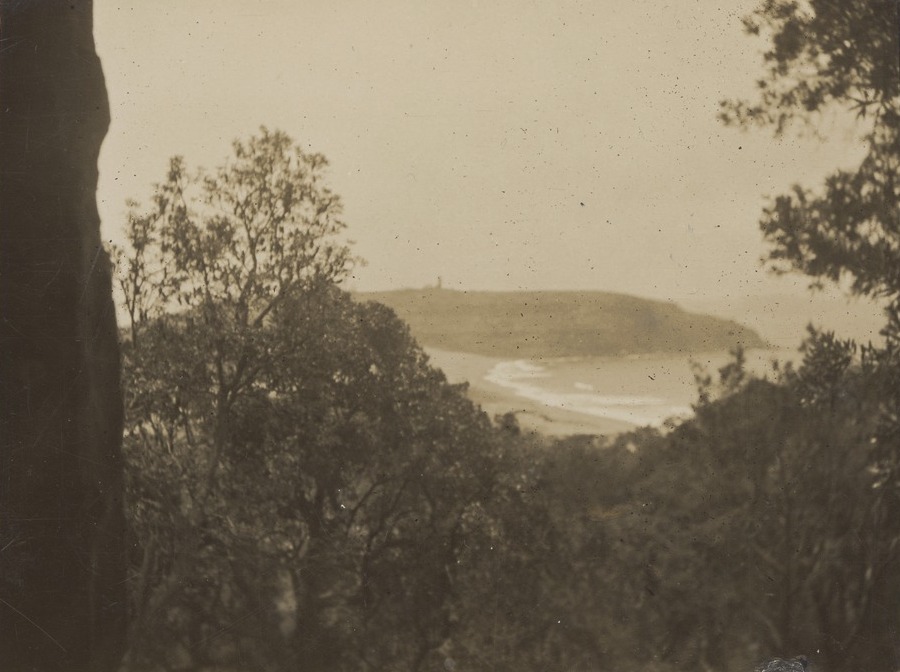
Barrenjoey Head and lighthouse

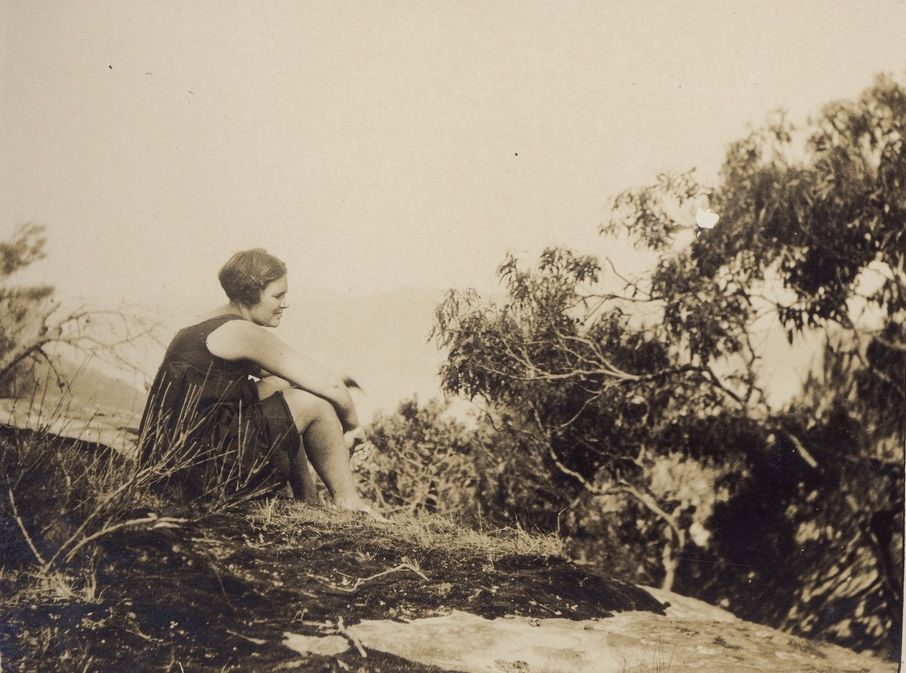
On a lookout in Kuringai Chase
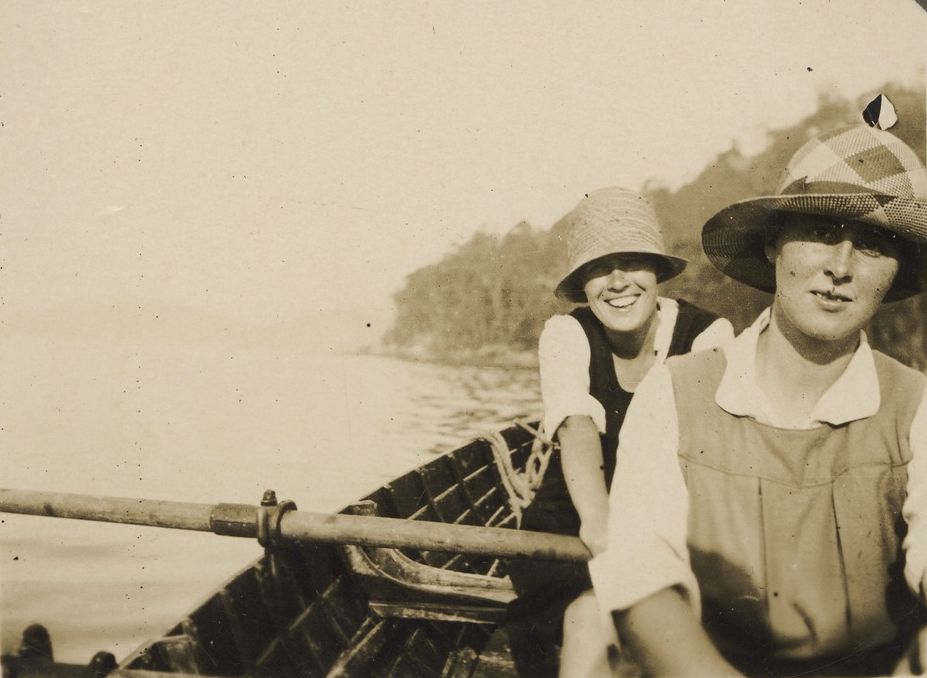
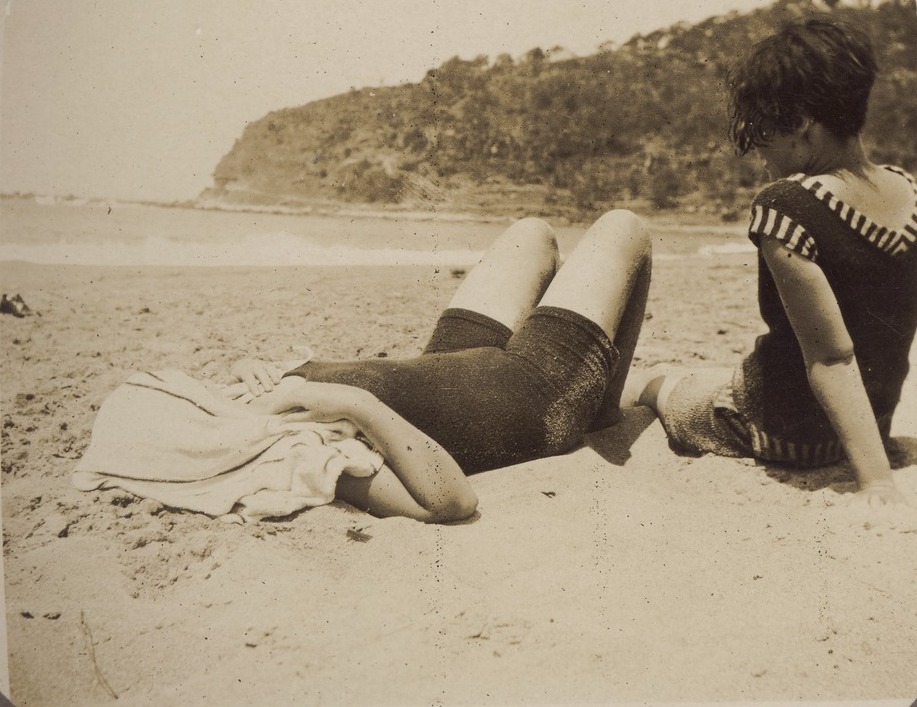

Capricorn Floating Hotel from: Advertising (1950, February 18). The Sydney Morning Herald (NSW : 1842 - 1954), , p. 22. Retrieved from http://nla.gov.au/nla.news-article18146119
Across the blue water for a camping holiday: 1950
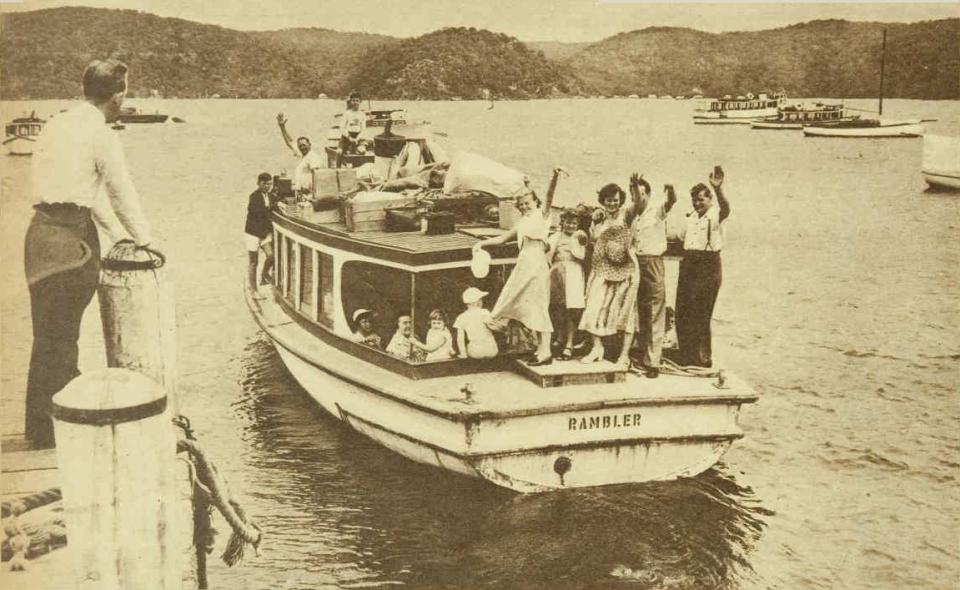
Across the blue water for a camping holiday
PACKING LINEN in the aluminium bath at home in Willoughby, Sydney, are Roy Dutch, his wife Olive, daughters Eileen and Lois. In adjoining room, packing cutlery and kitchen utensils, are daughters Mavis and Enid. Mrs. Dutch takes 10 pairs of sheets, washes a sheet a day during holiday.
LOADING UP THE TRAILER. Years of camping have taught the Dutch family discrimination in packing. They take only what is needed for comfort, leave behind non-essentials, which add to the burden of travelling and clutter up the camp. To pack and load the trailer takes more than two hours.
Camping these days does not mean roughing it, with ants in the jam and sour m i I h in the tea. modern campers take with them all kinds of amenities. Here is the holiday story of one of the thousands of IMAtralian families who camp at the seaside.
FREEDOM AHEAD. With luggage for their summer camping holiday piled on the cabin-top of the launch-ferry Rambler, the Dutch family and other holiday-makers wave good-bye to Palm Beach wharf as they set off across Pittwater for The Basin, on opposite shore, 20 miles from Sydney. The Basin is a favorite ground for hundreds of camping fans, and the Dutch family have spent holidays there for years. Ferry trip - only connection with mainland - is highlight of annual pilgrimage.
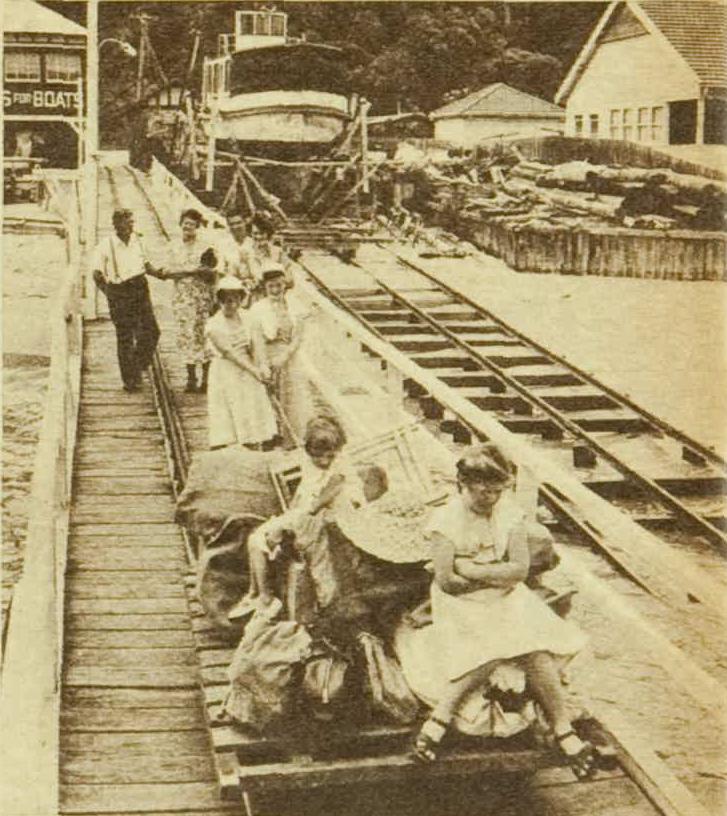
DOWN THE JETTY. Before casting-off children ride on rail-trolley at Palm Beach, where car, trailer are garaged.
WHEN THE TENT IS PITCHED, Enid, Mavis, and Eileen fill their palliasse with straw. They take pillows from home, sleep under six long blankets sewn together. The long bed, which stands firmly on pipe legs, is divided into six compartments for daughters. Palliasse hay is brought in bale from home.
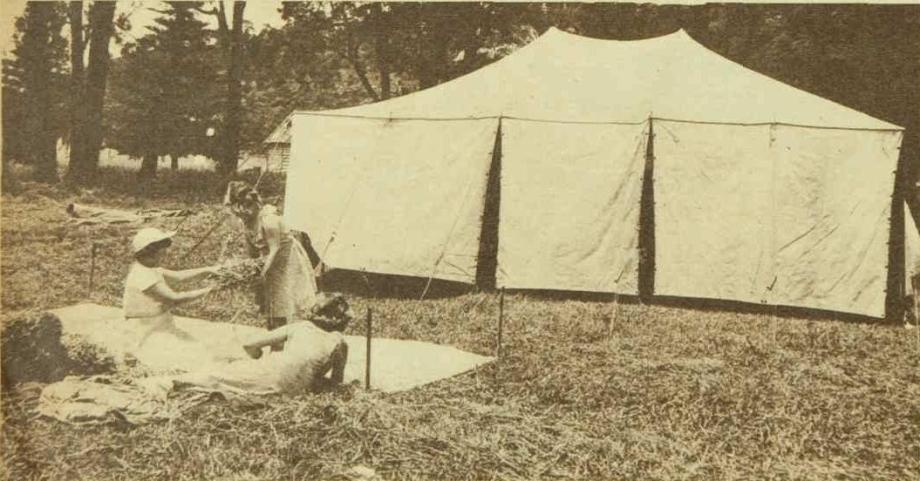
FIRST SWIM. While Mr. and Mrs. Dutch, and married daughter Joan, rest on the grass after making camp, the five other Dutch daughters race off for a swim in the shark-proof pool, enclosed by steel mesh. Pool is shallow for many yards from the shore, is considered perfectly safe for children.
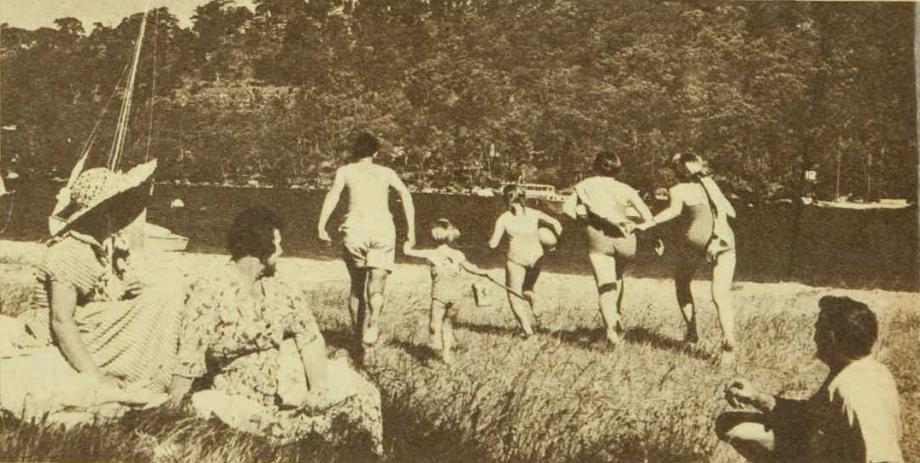
Across the blue water for a camping holiday (1950, December 30). The Australian Women's Weekly (1933 - 1982), p. 12. Retrieved from http://nla.gov.au/nla.news-article47806278
The Basin, Pittwater - today
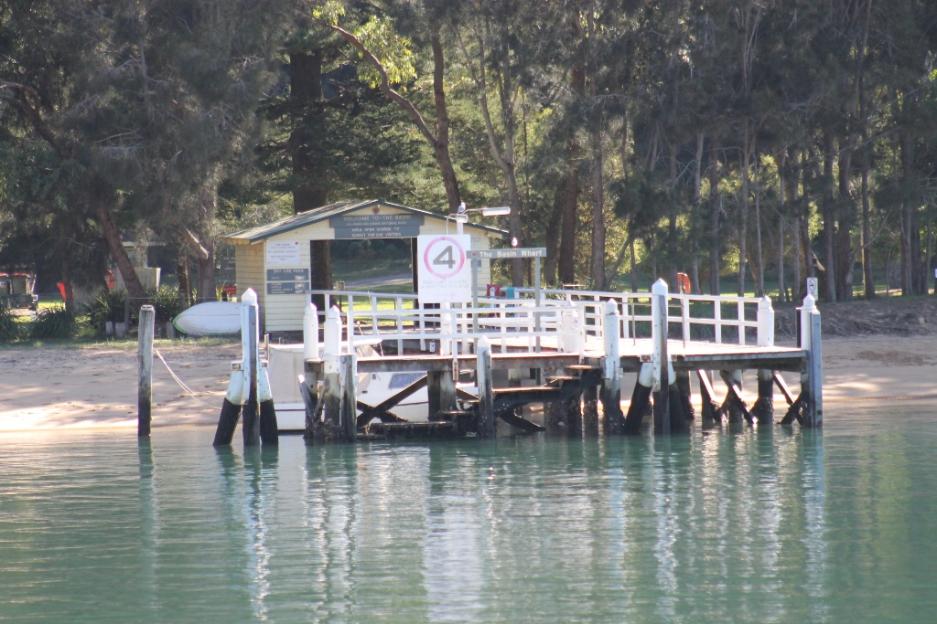
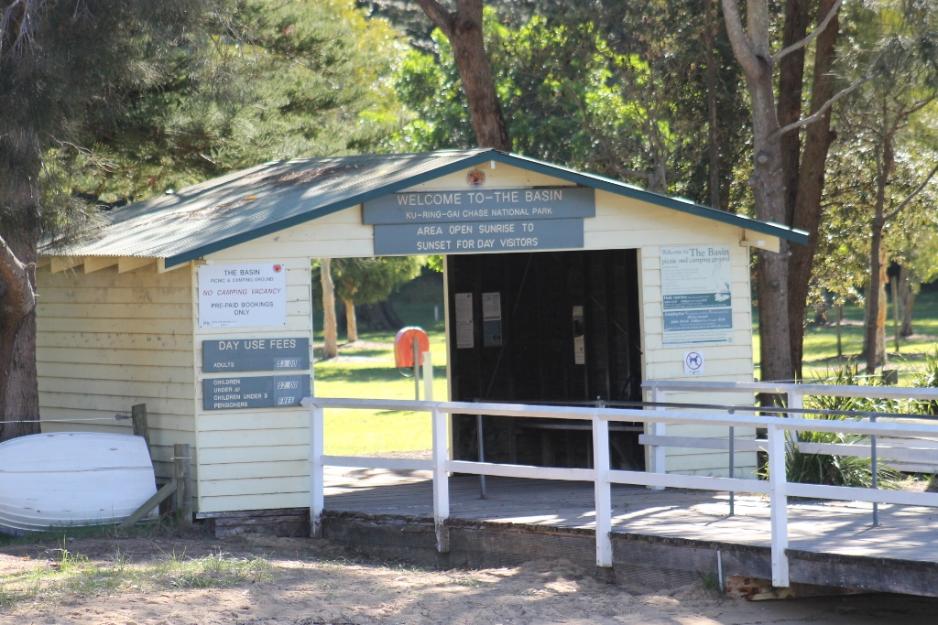
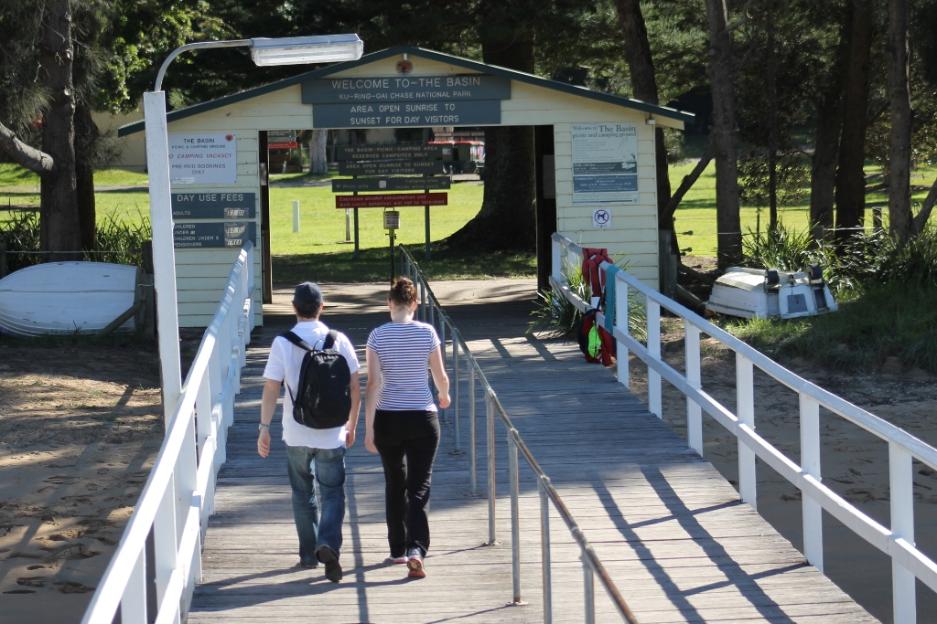
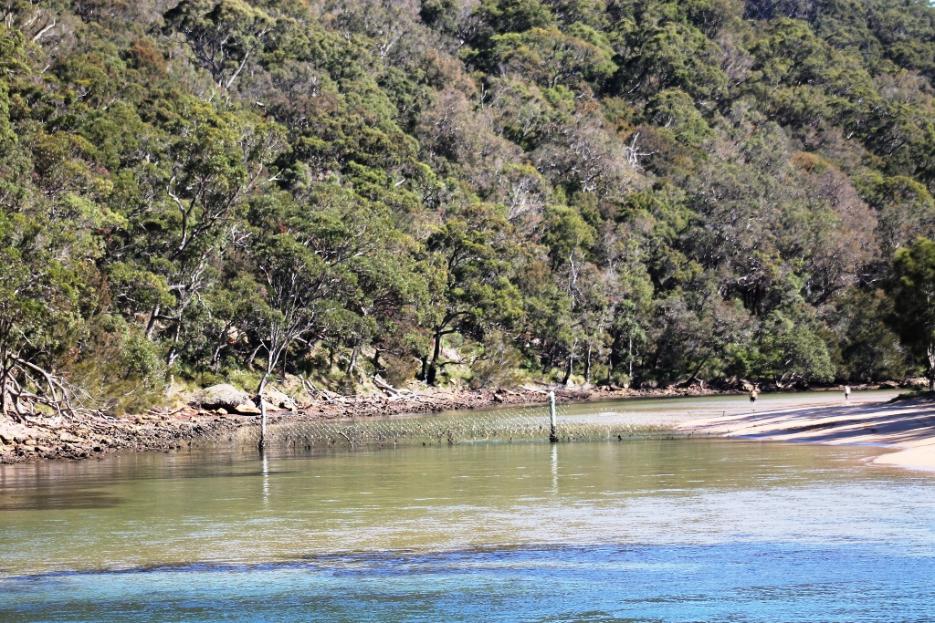
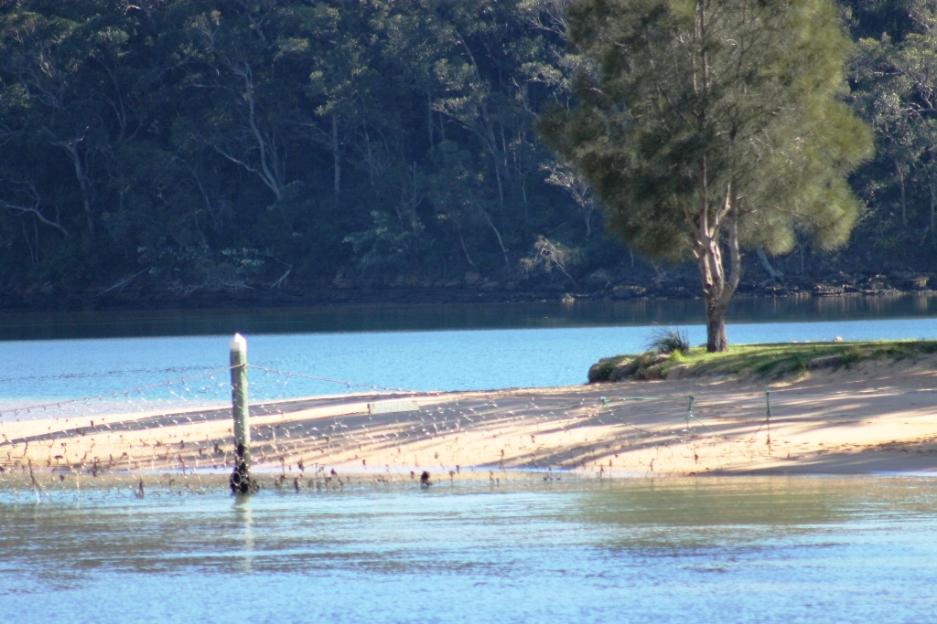
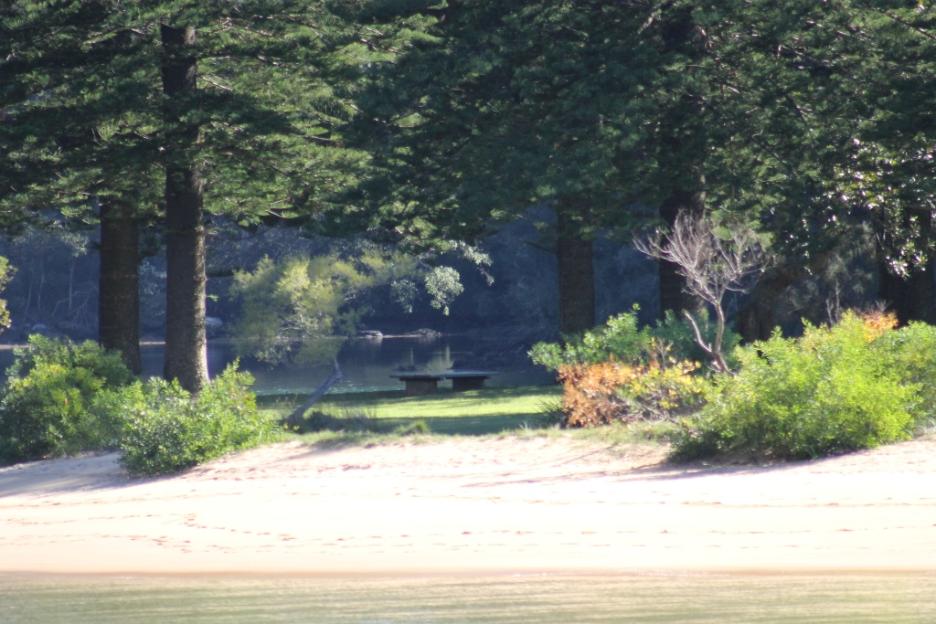
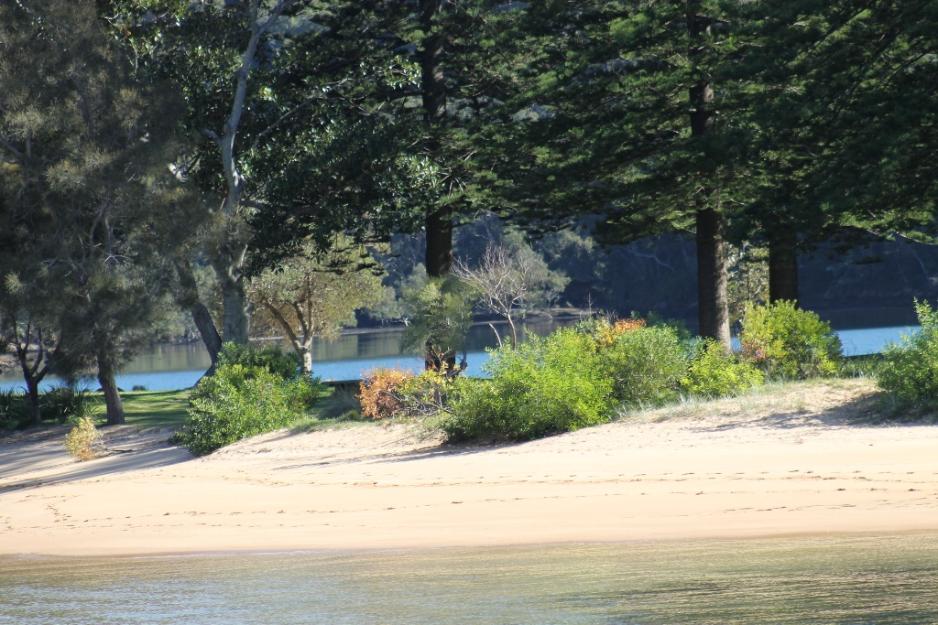
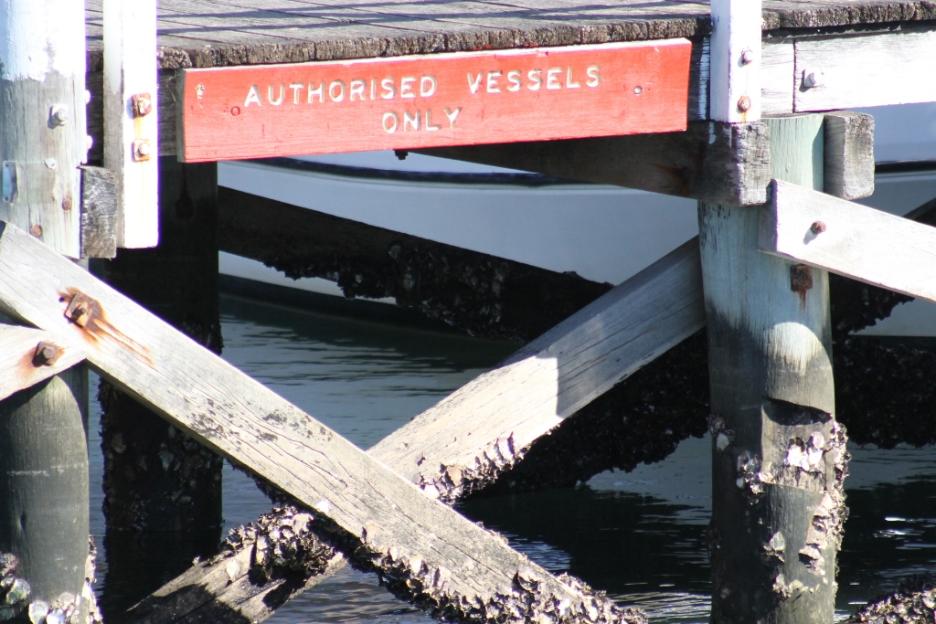
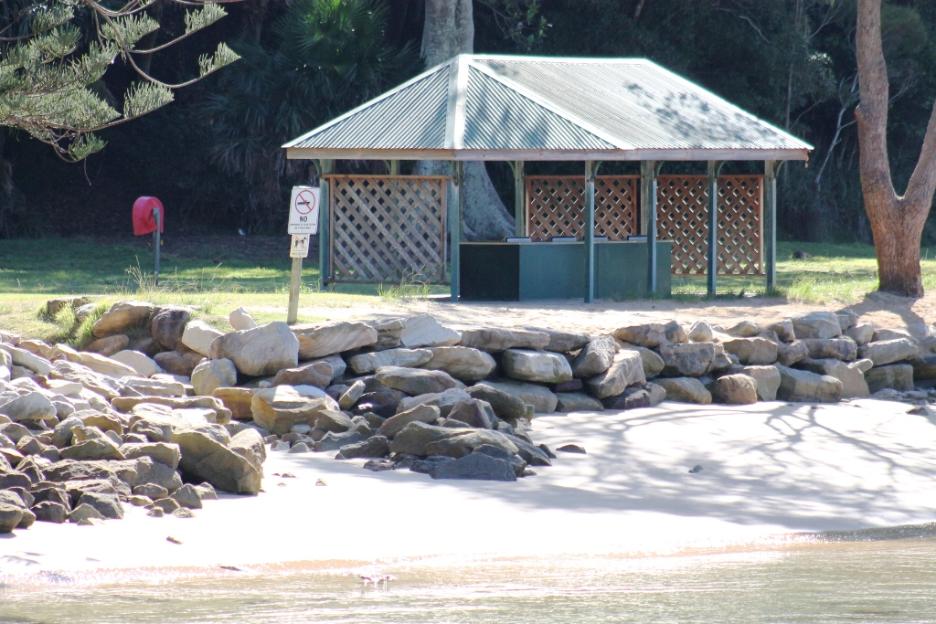
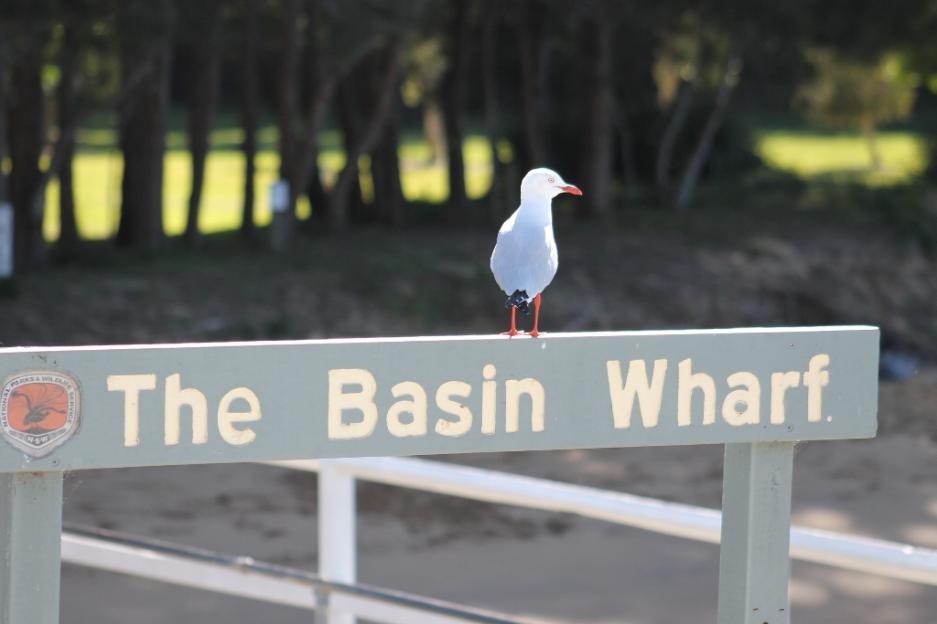
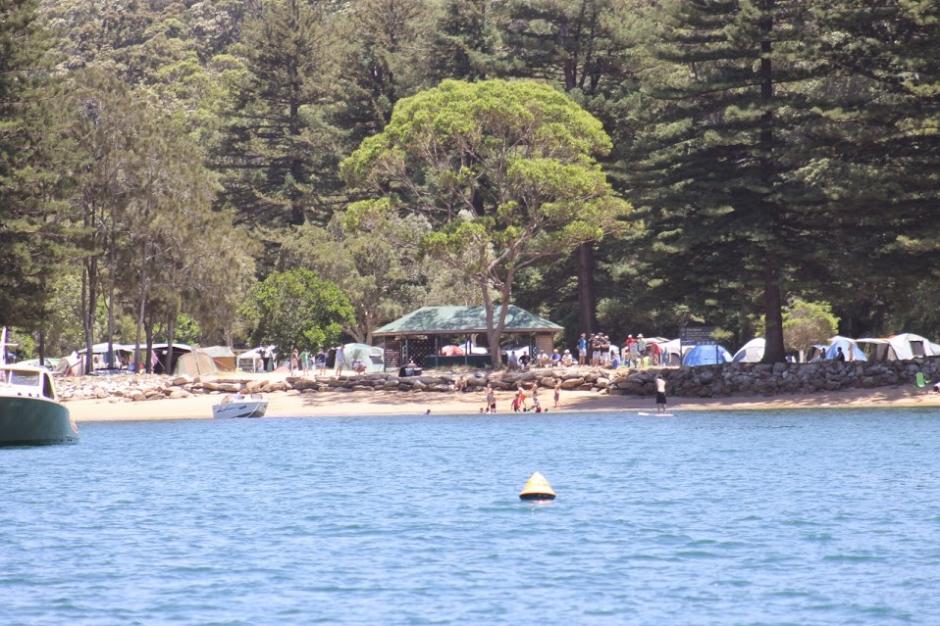
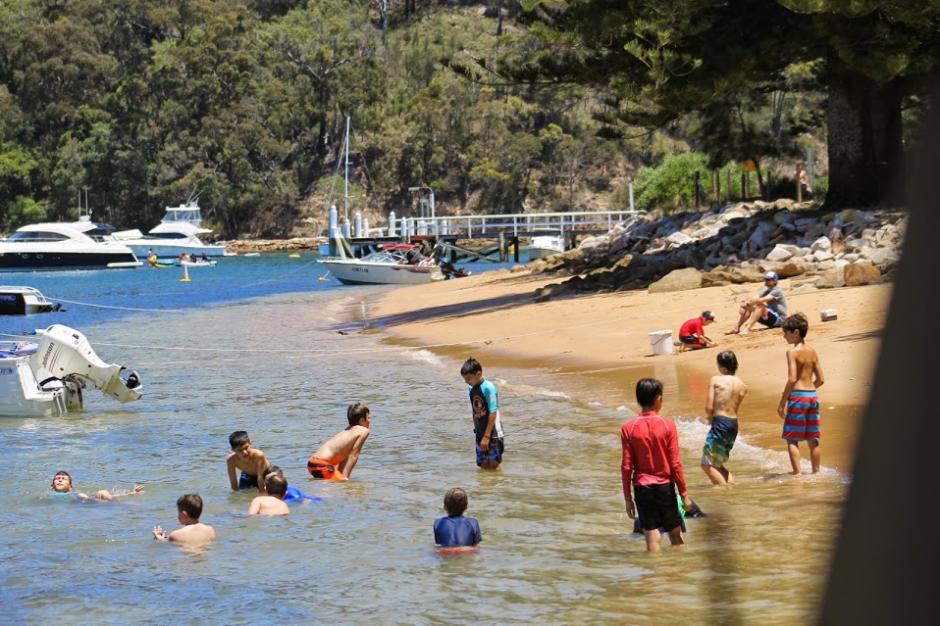
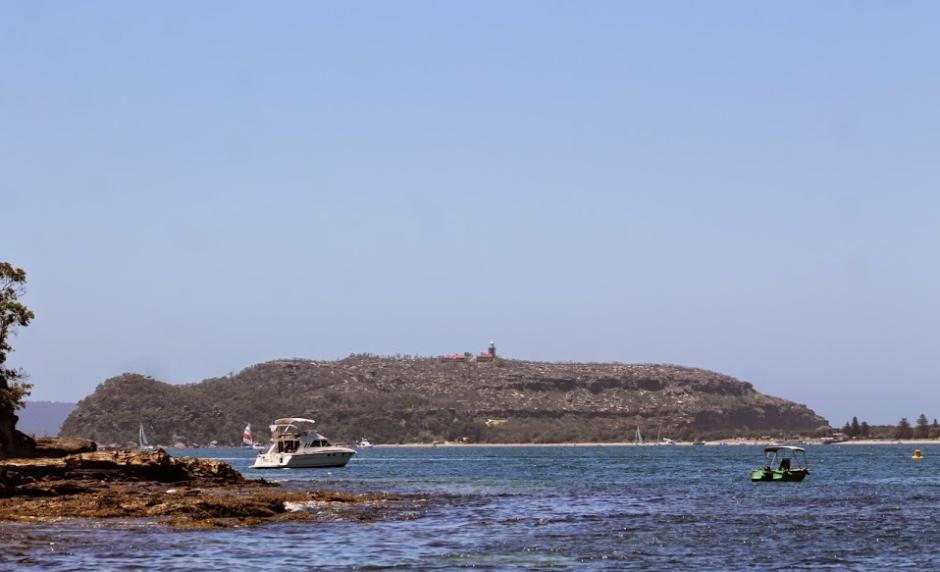
The Basin, Pittwater: A Reprise - Historical Pictures and Articles - threads collected and collated by A J Guesdon, 2016